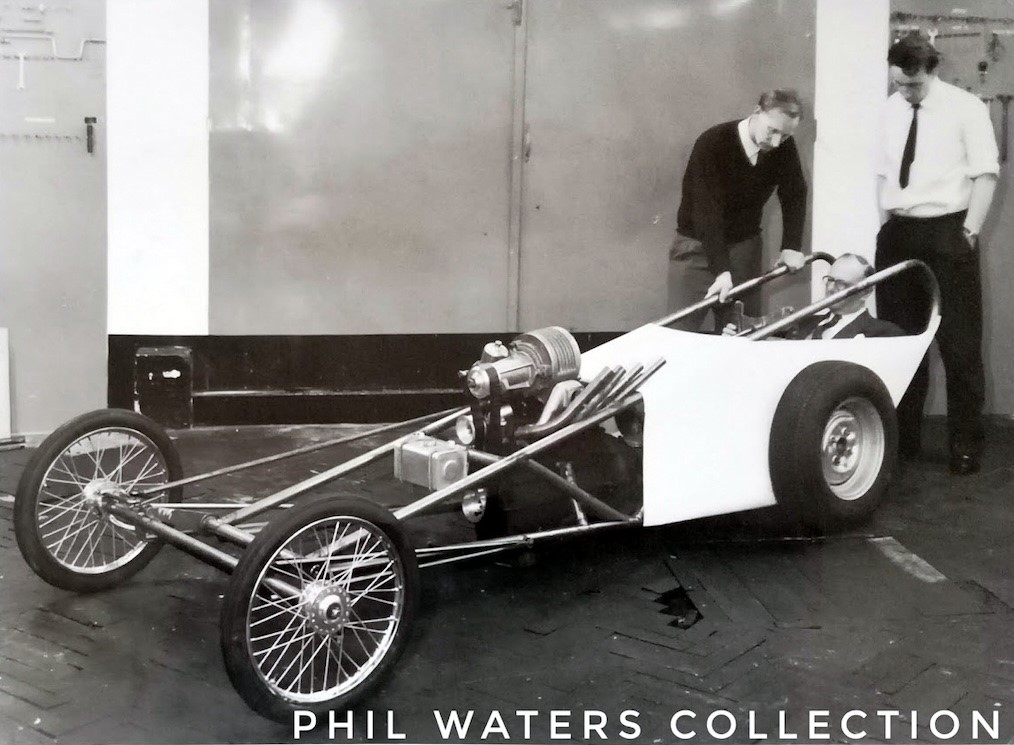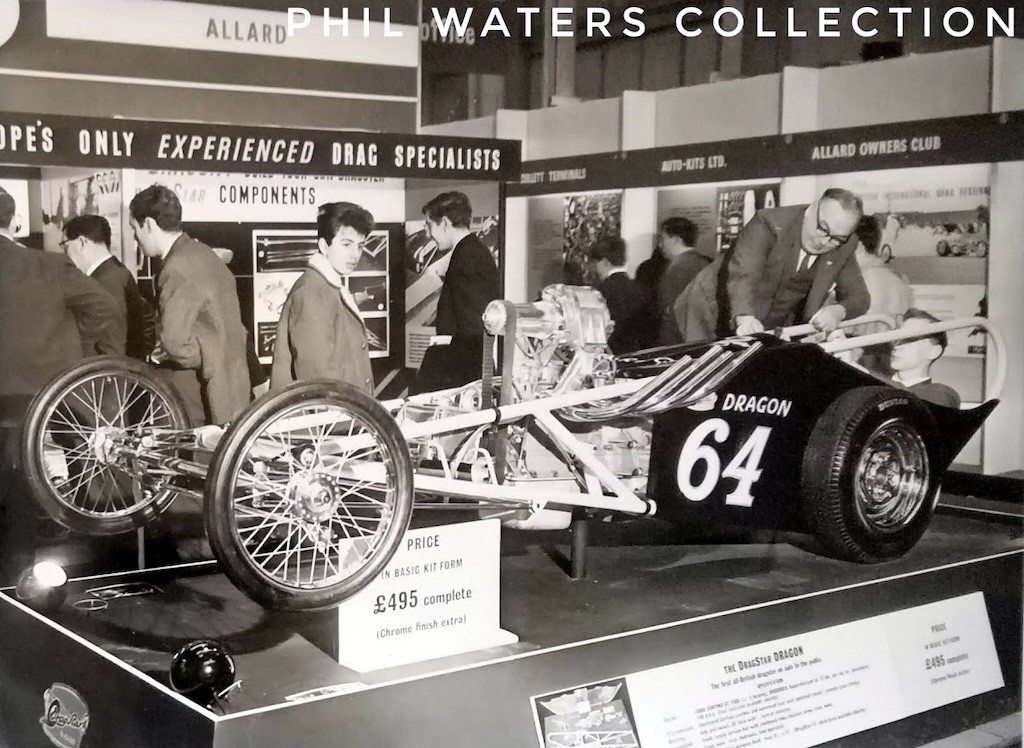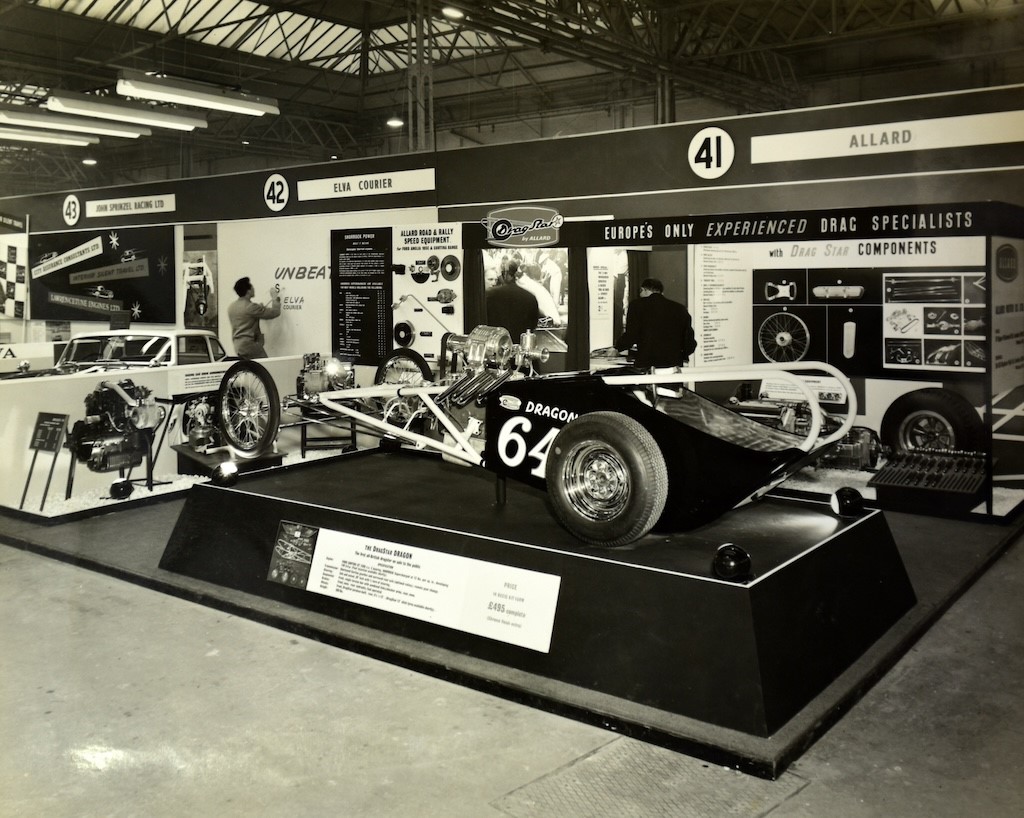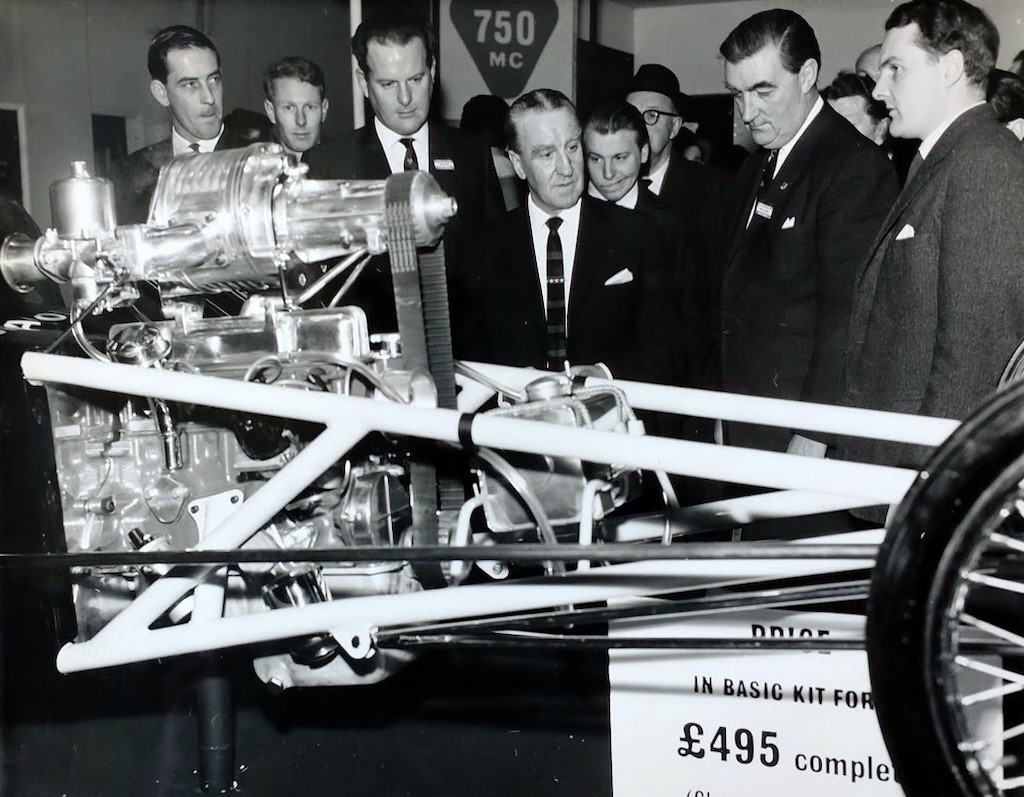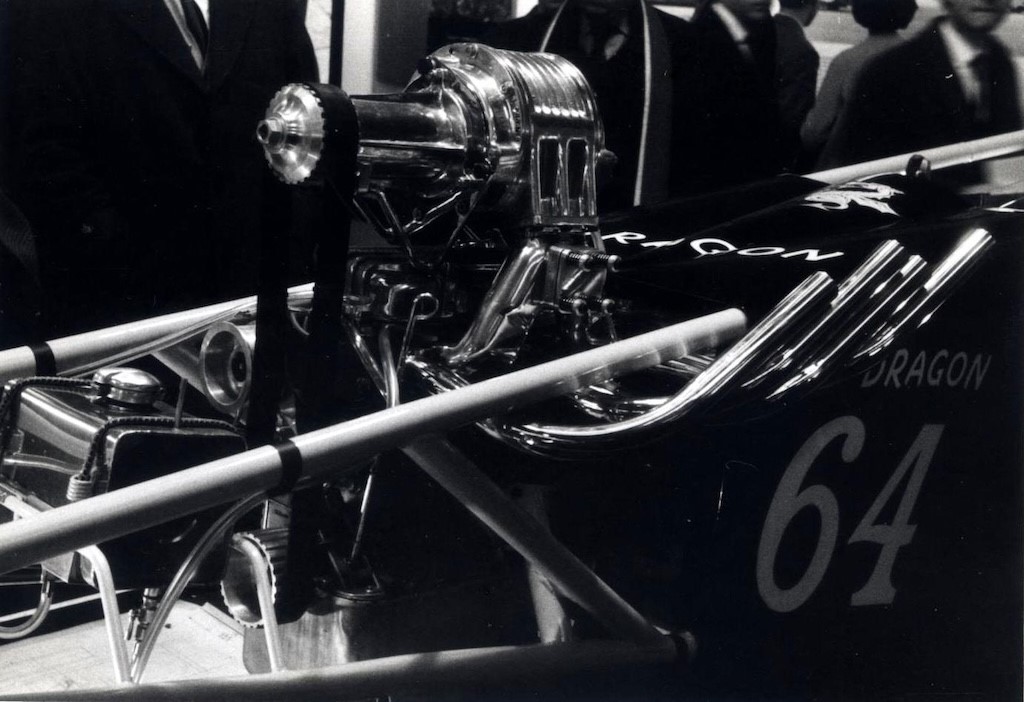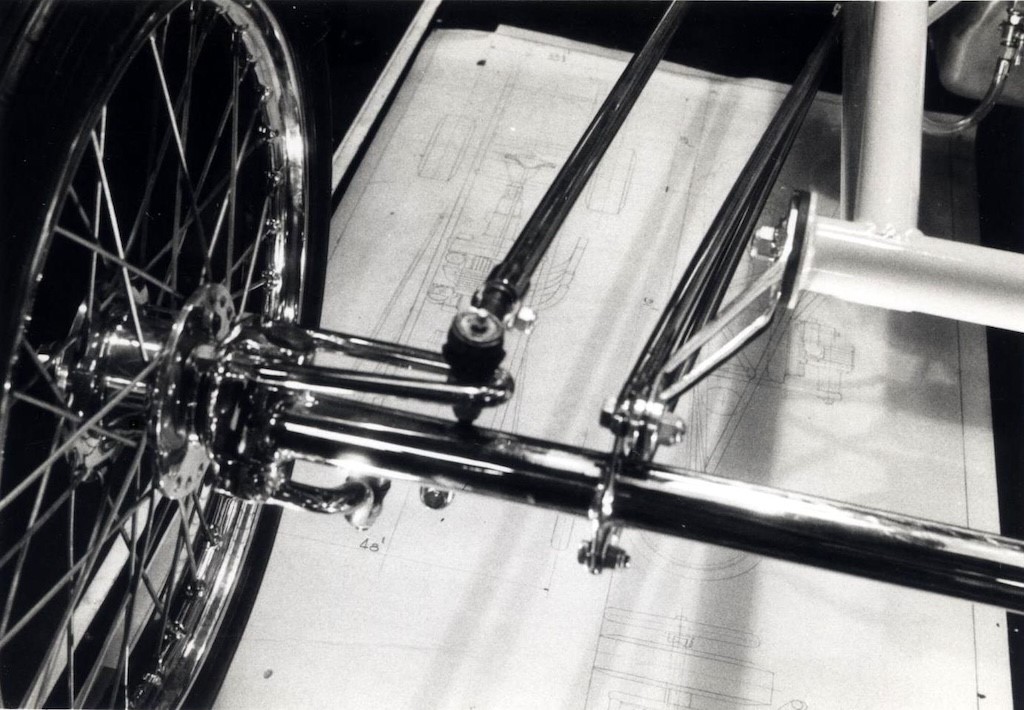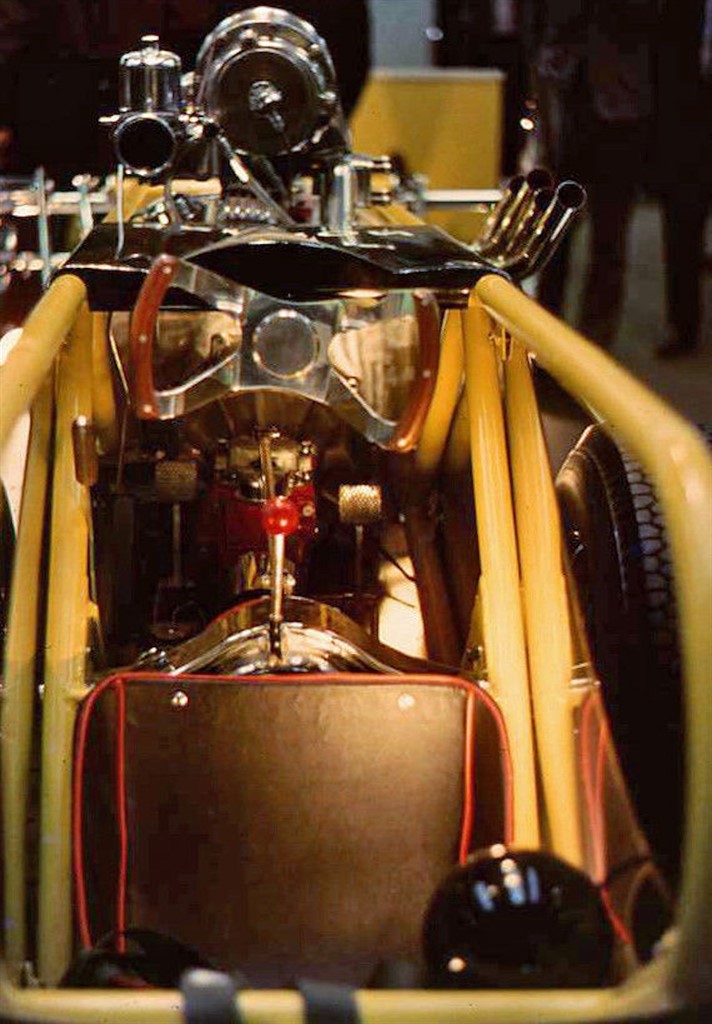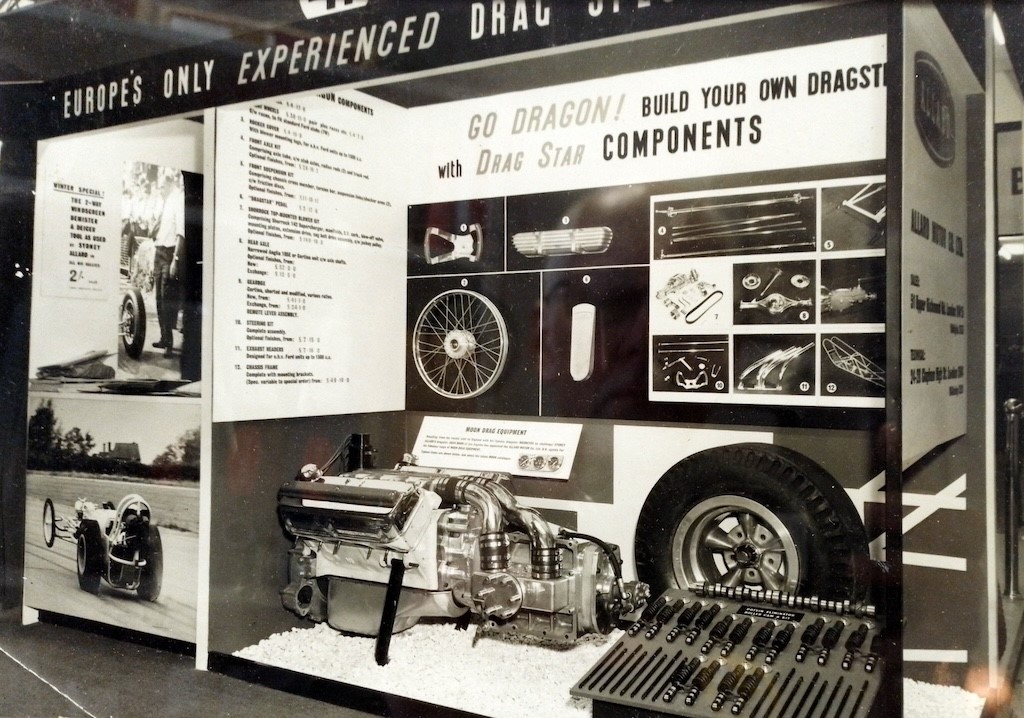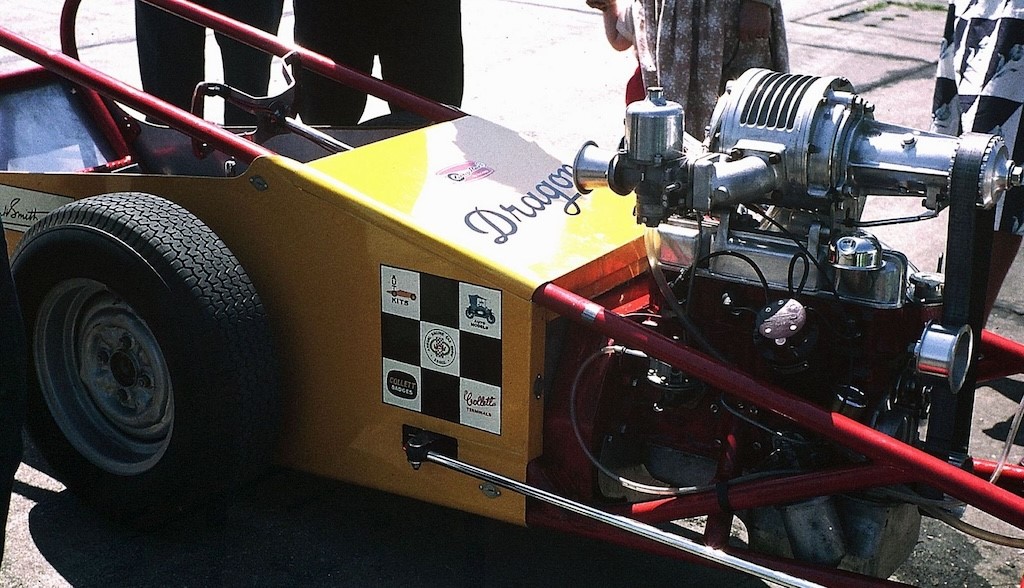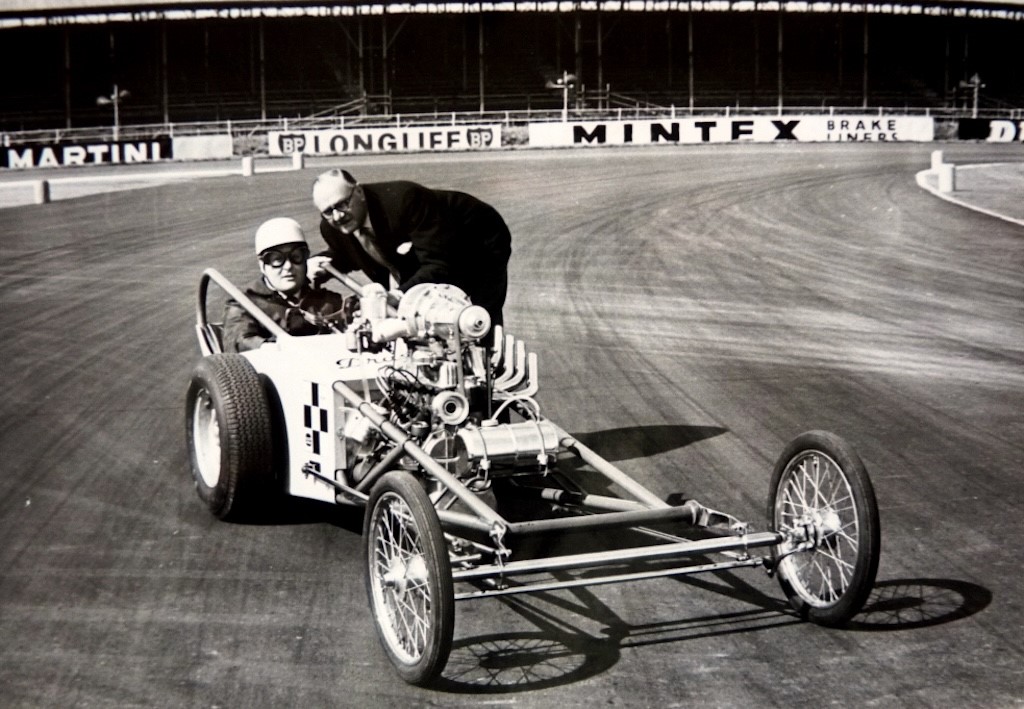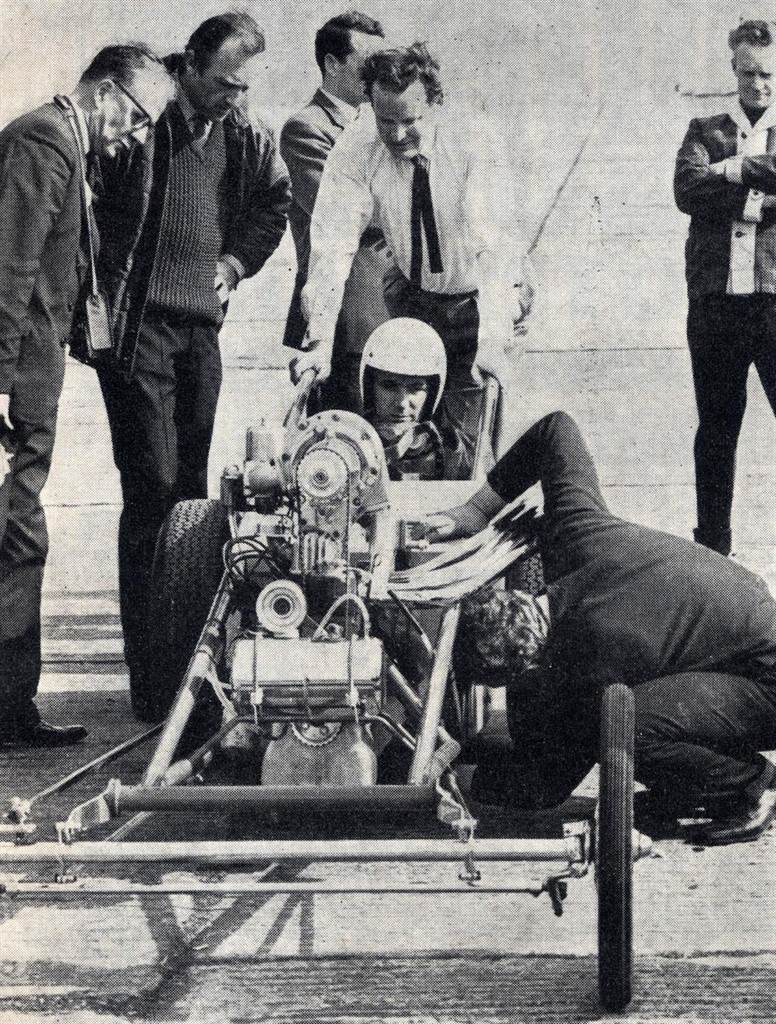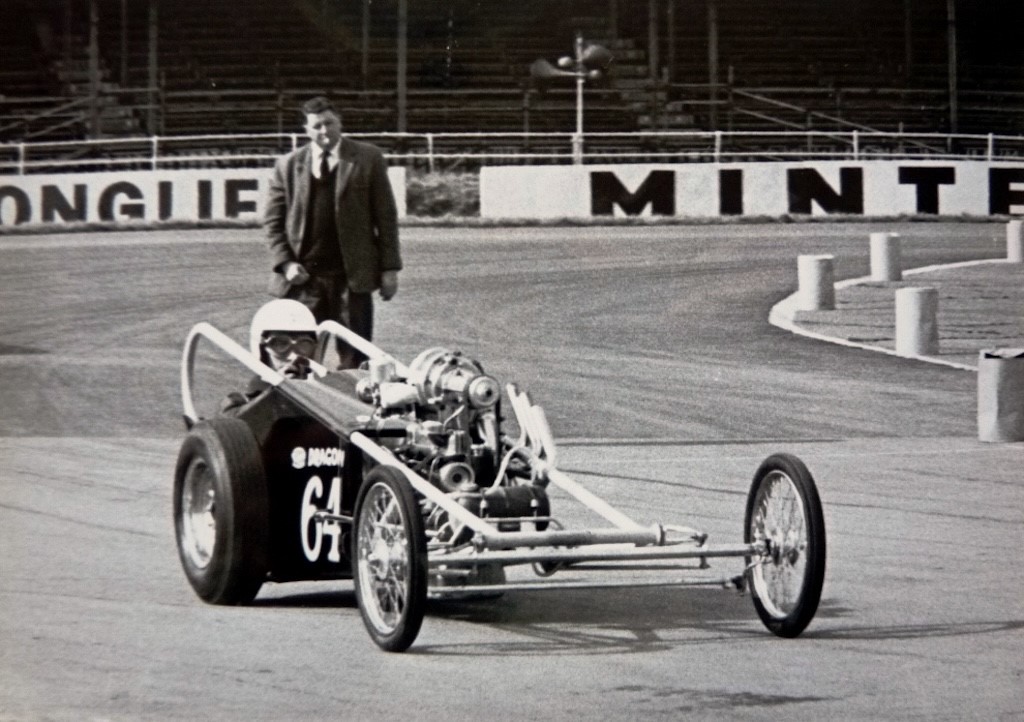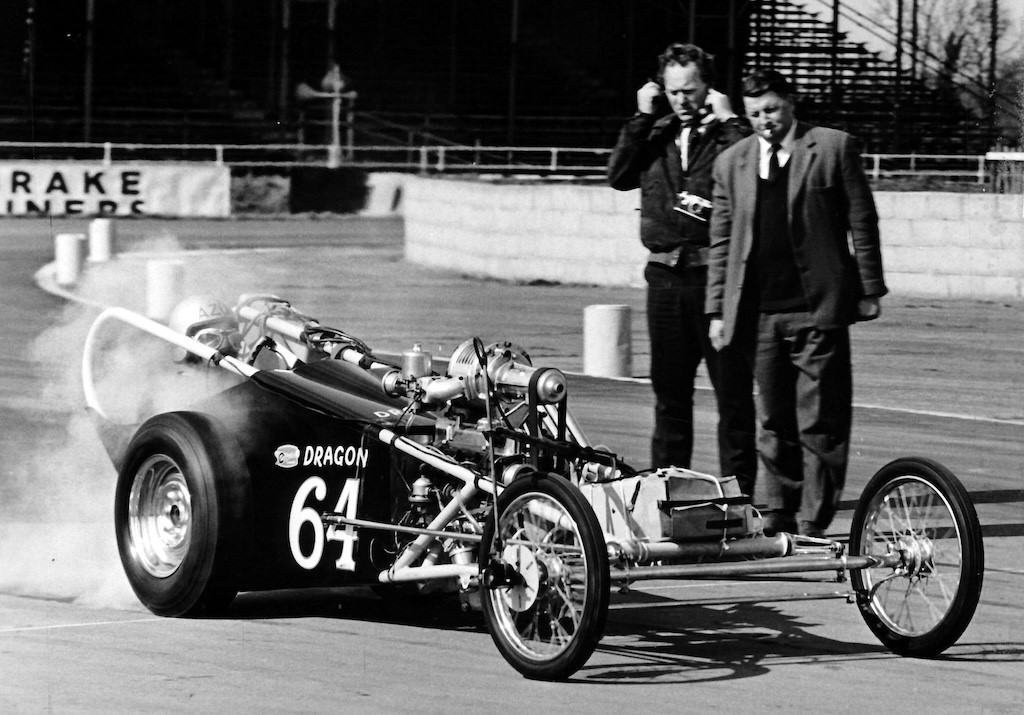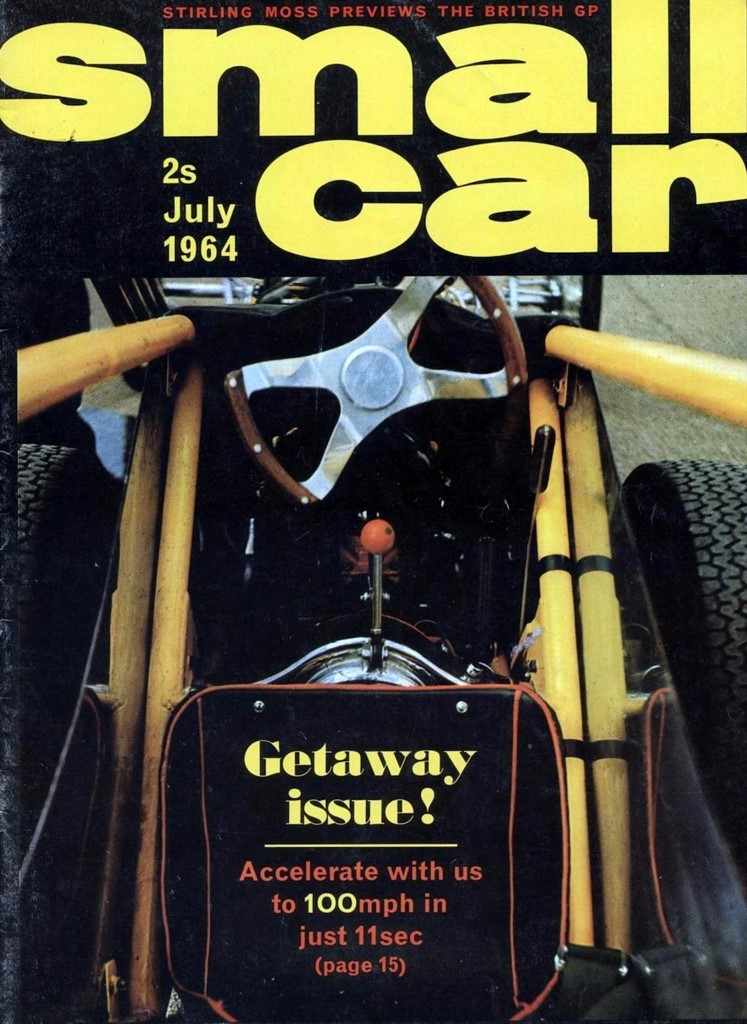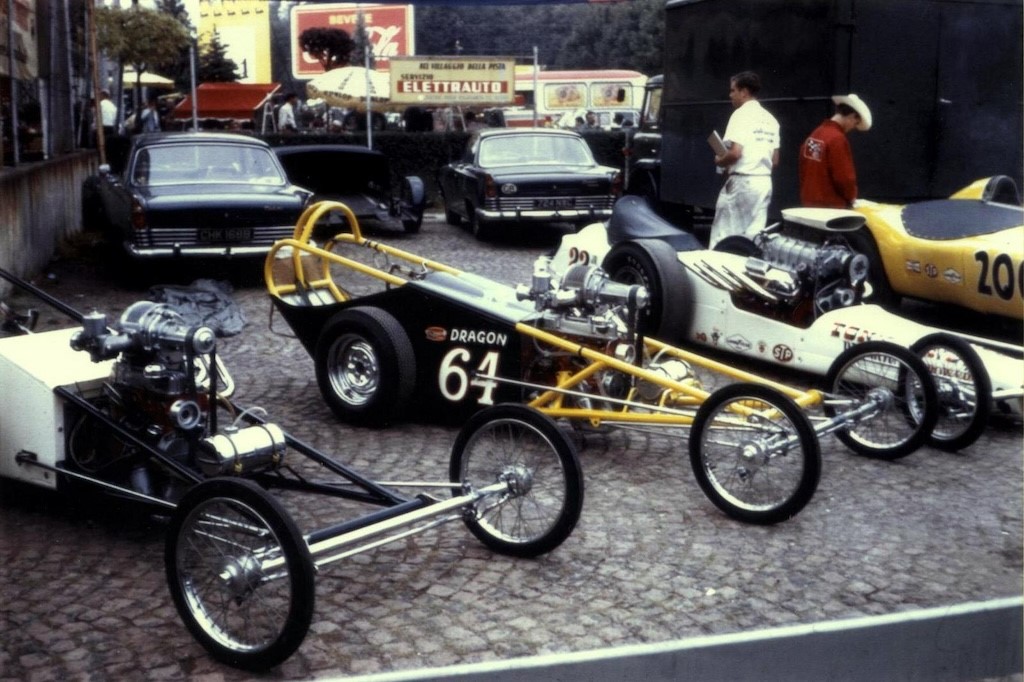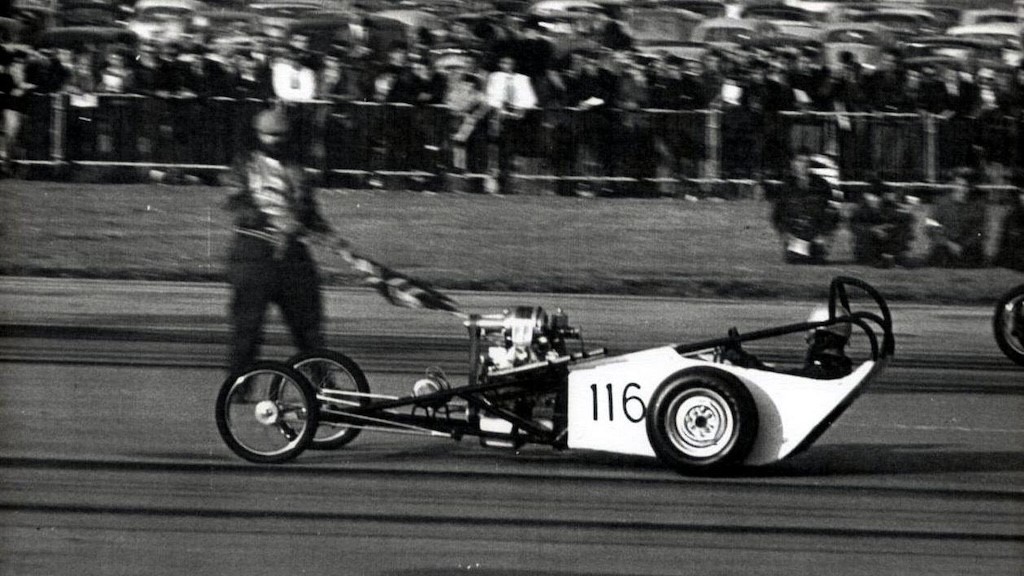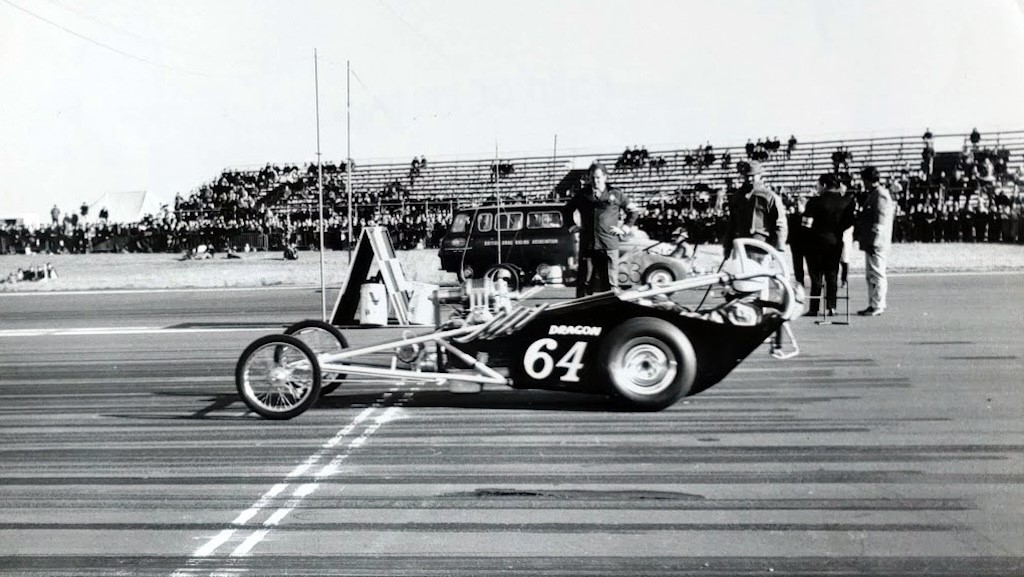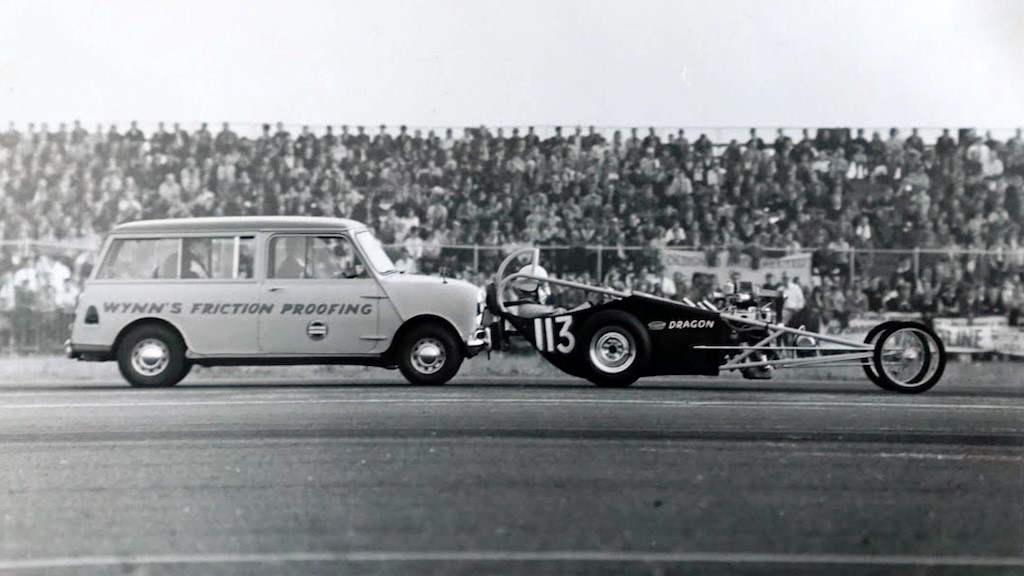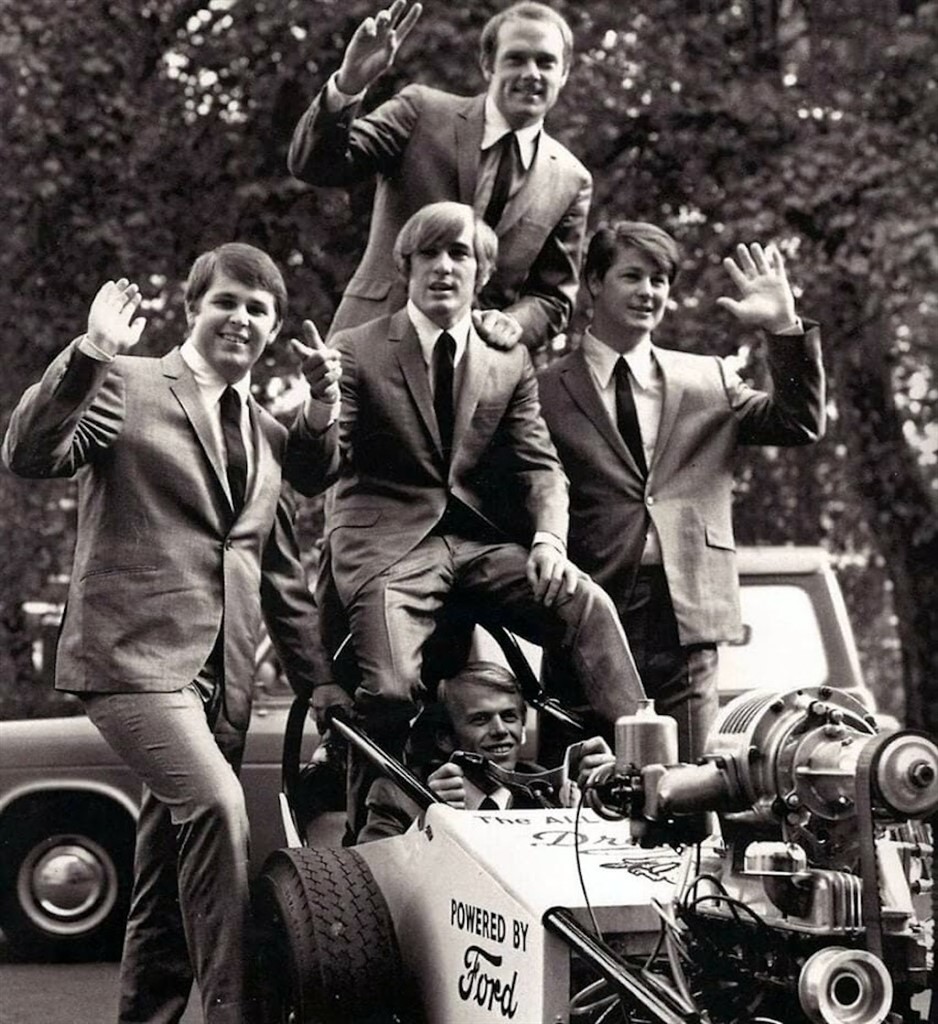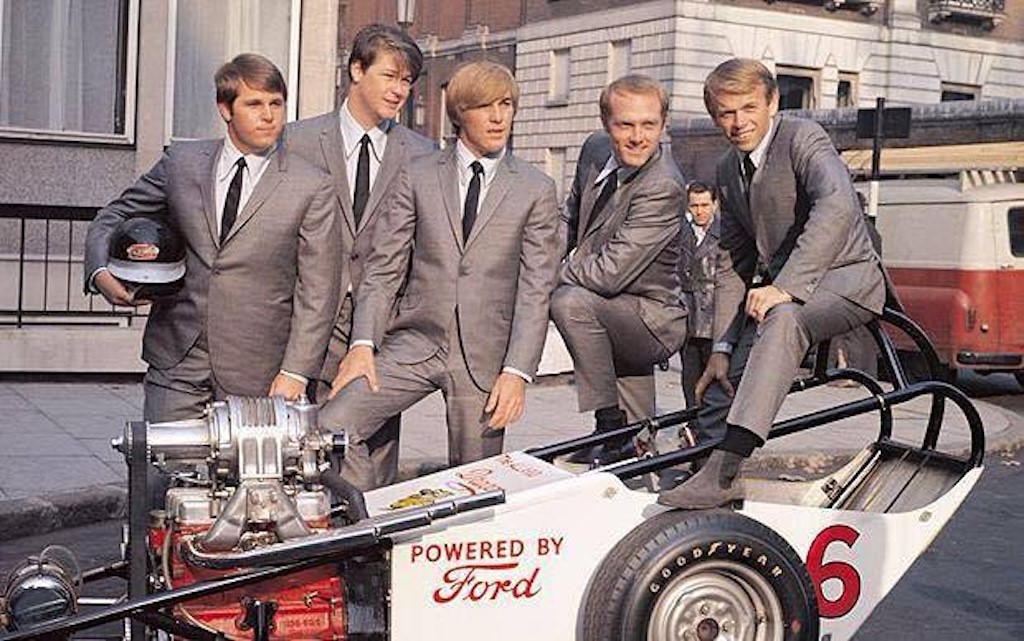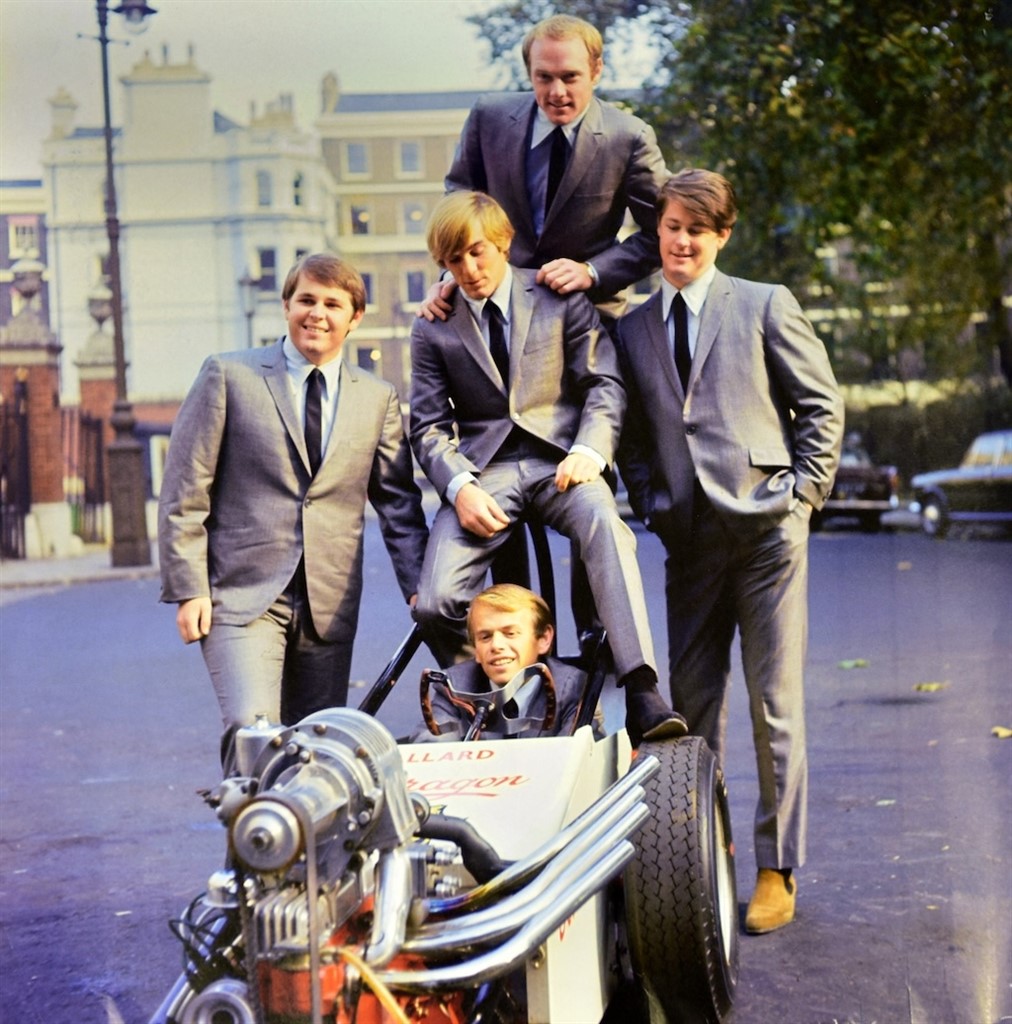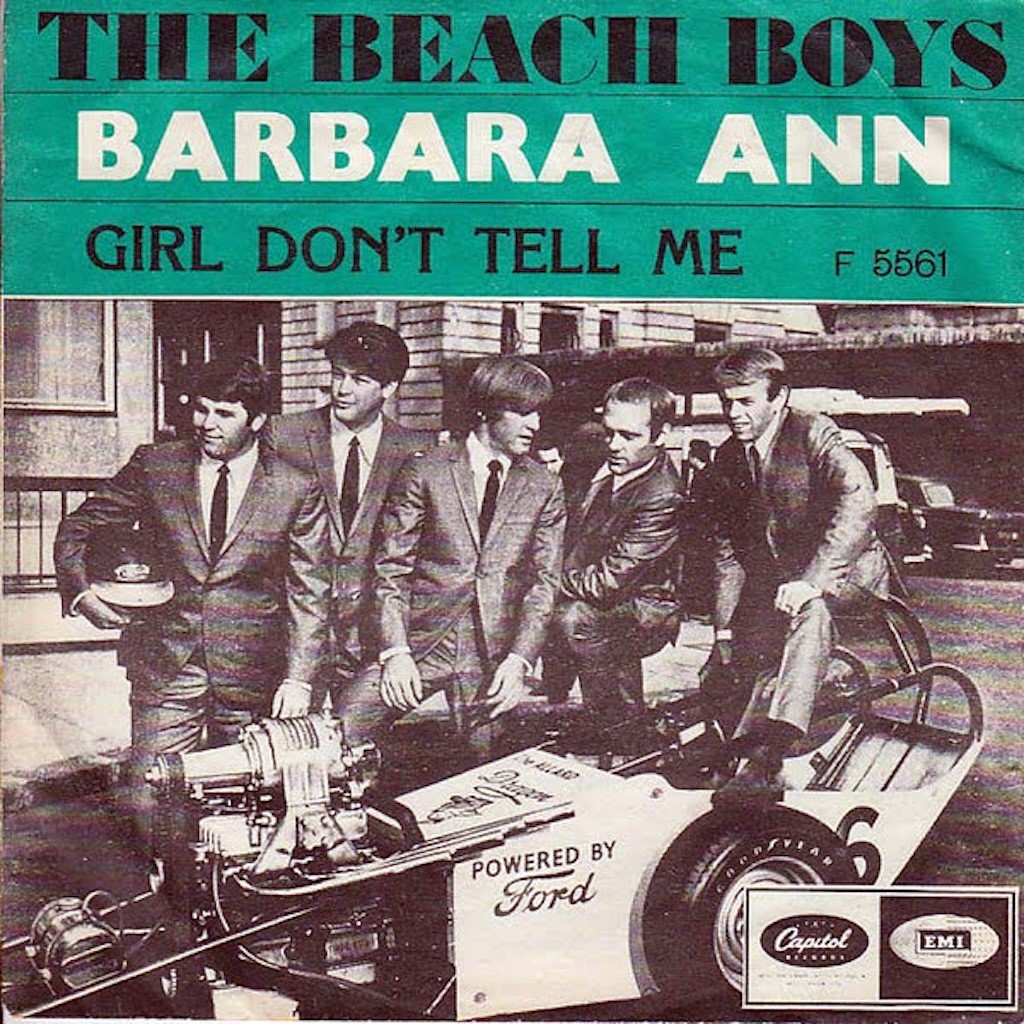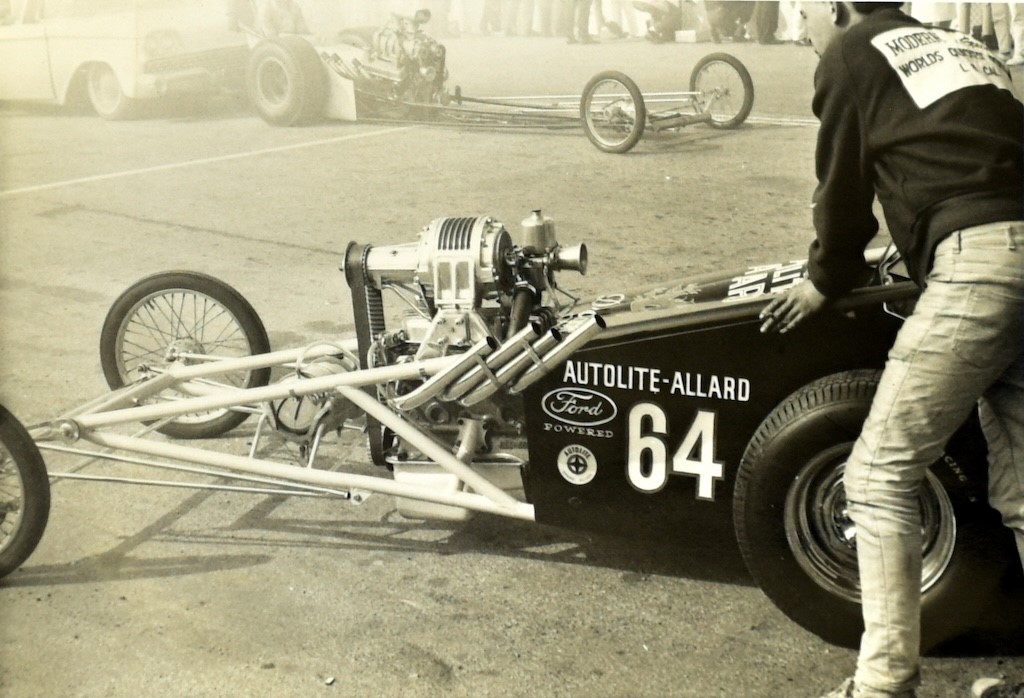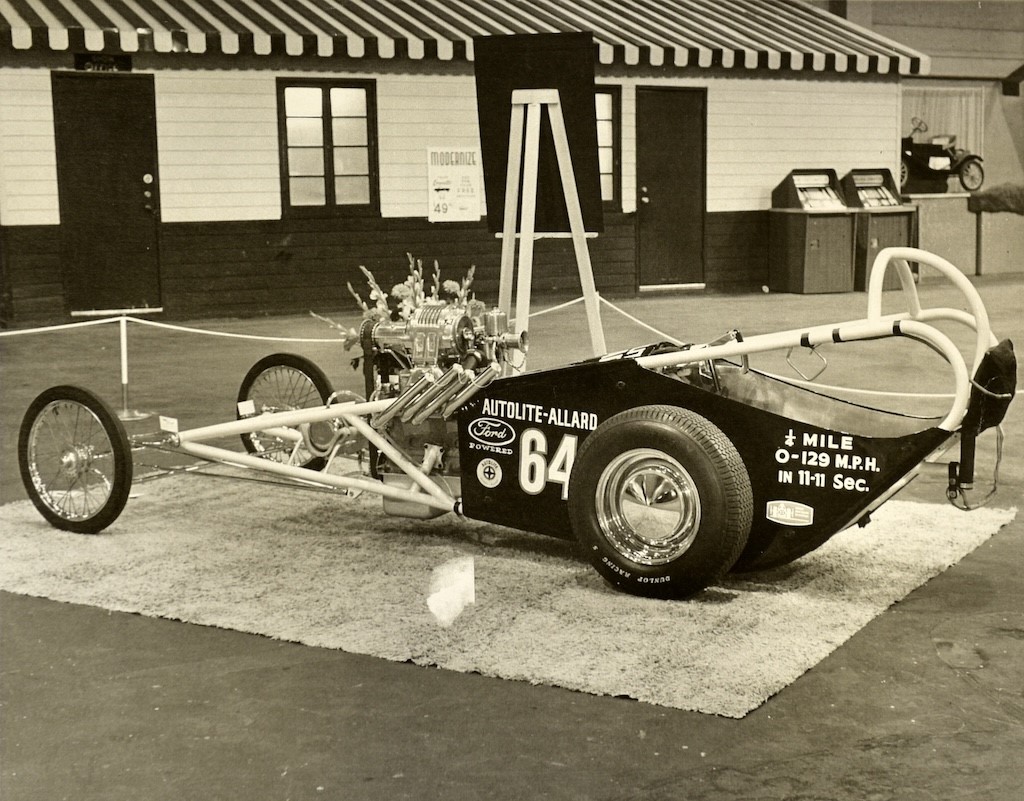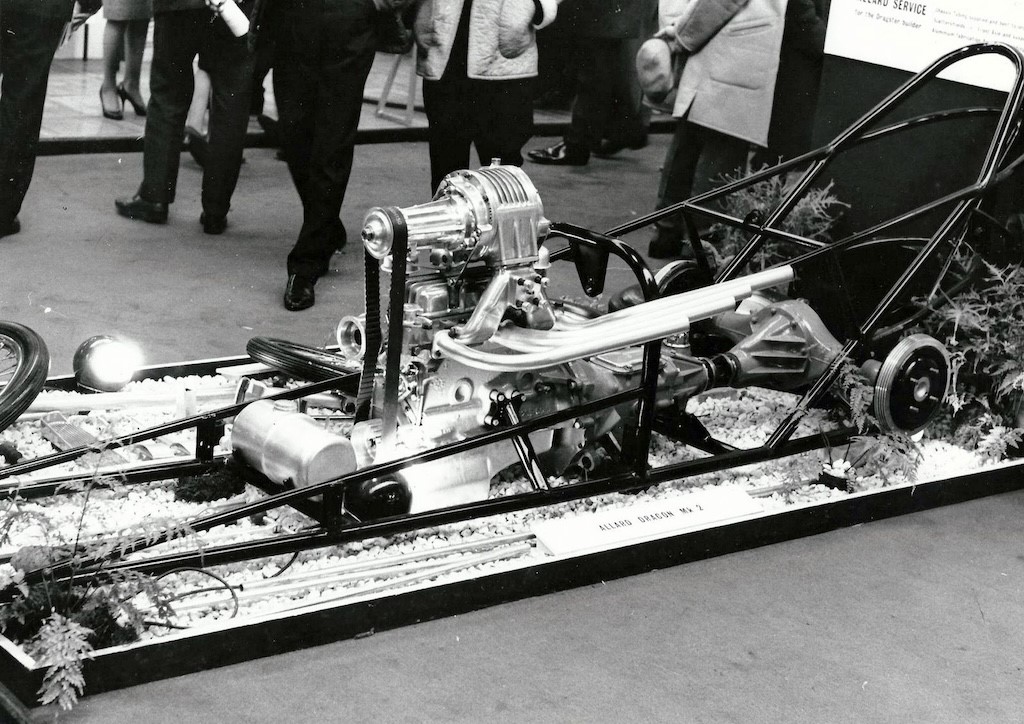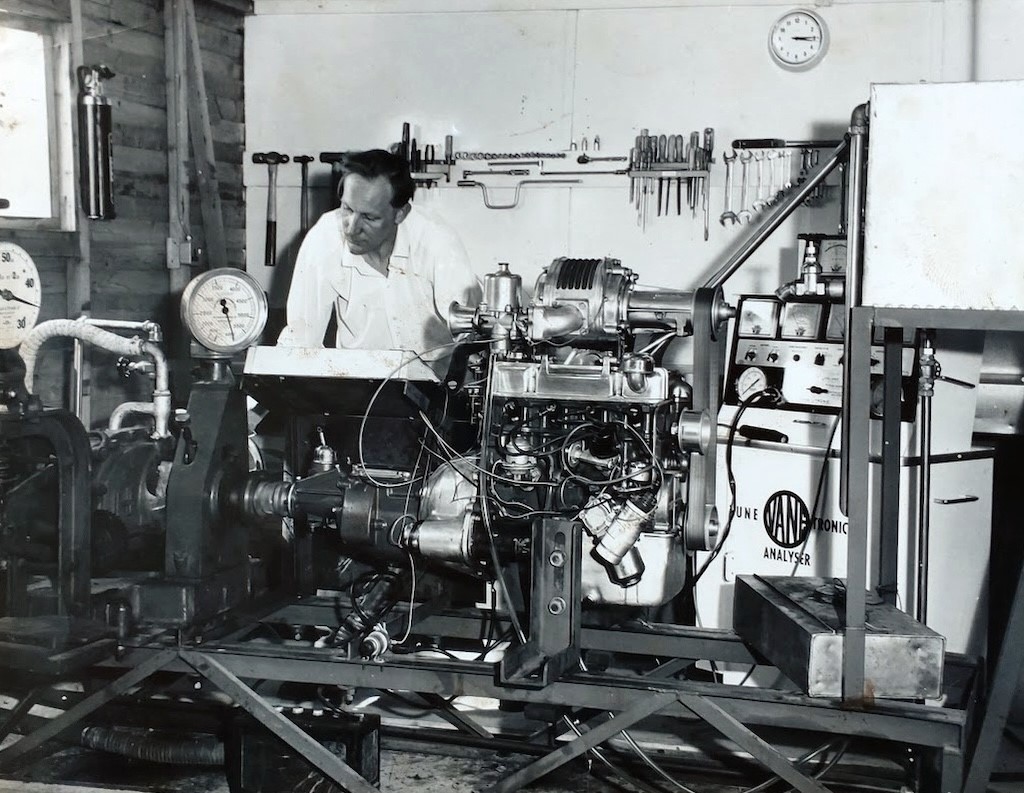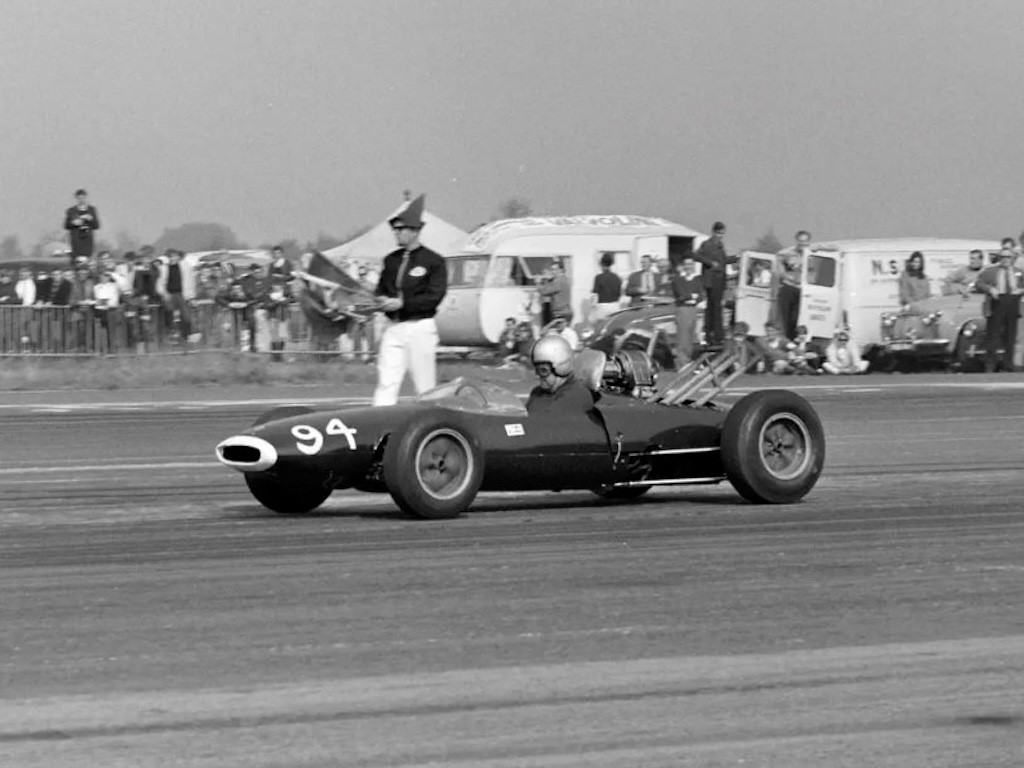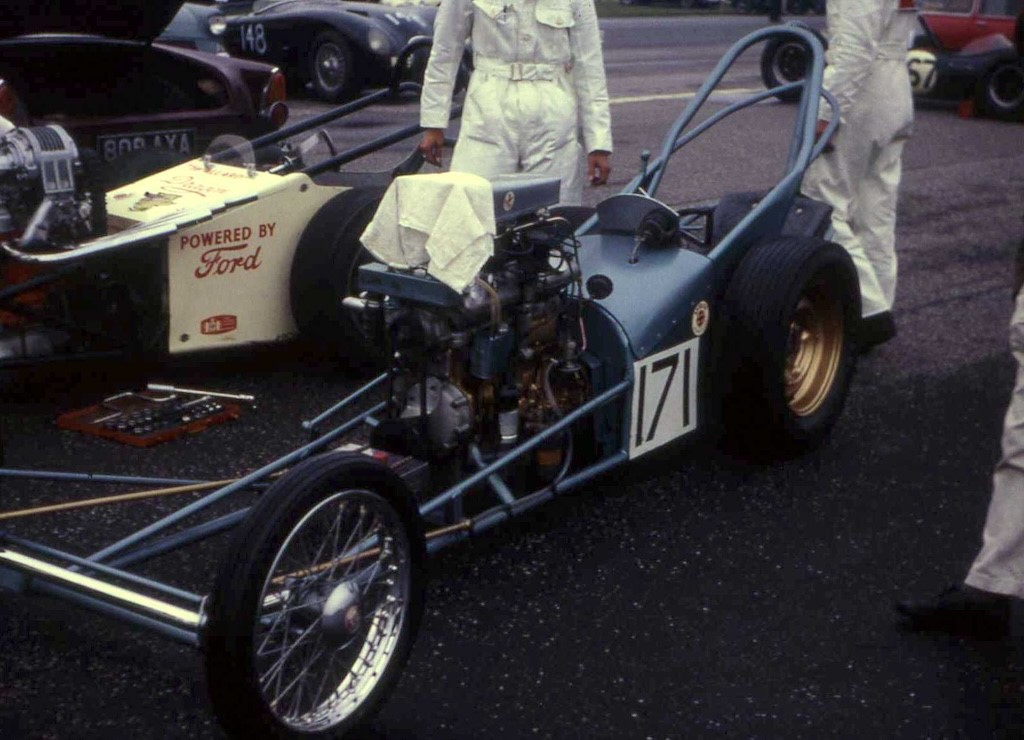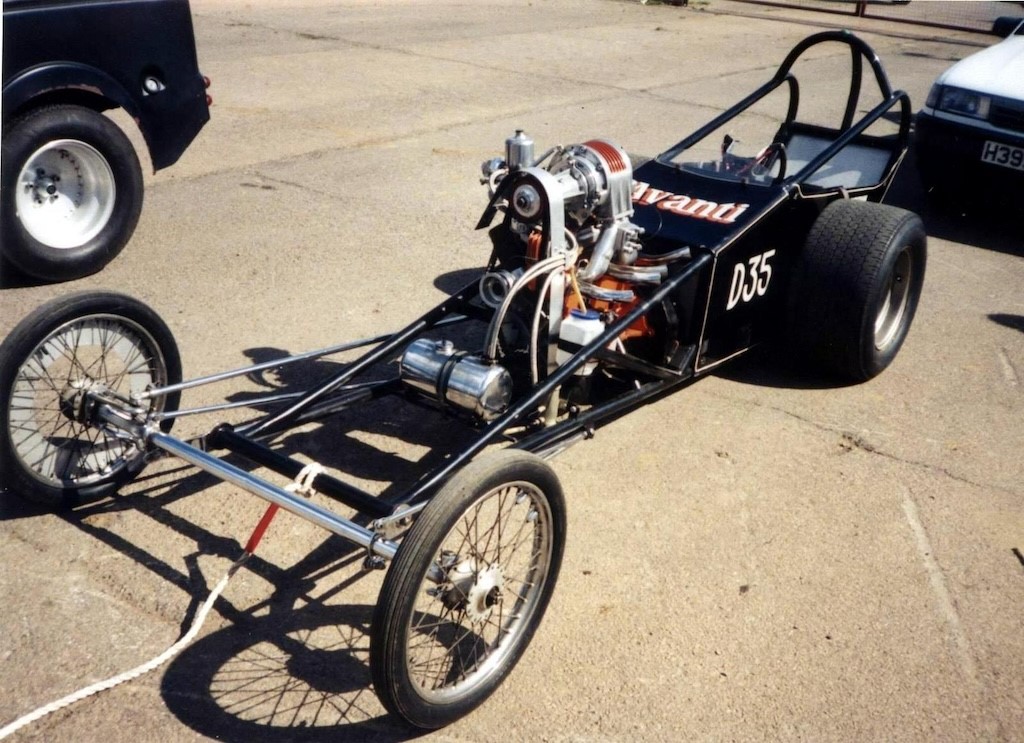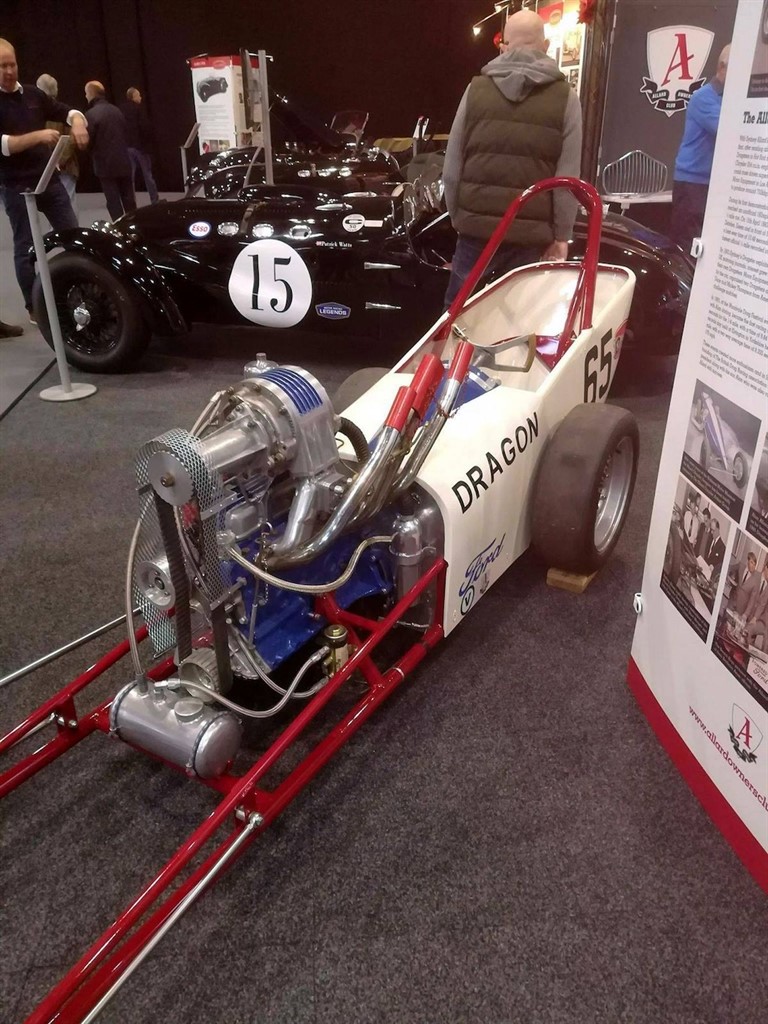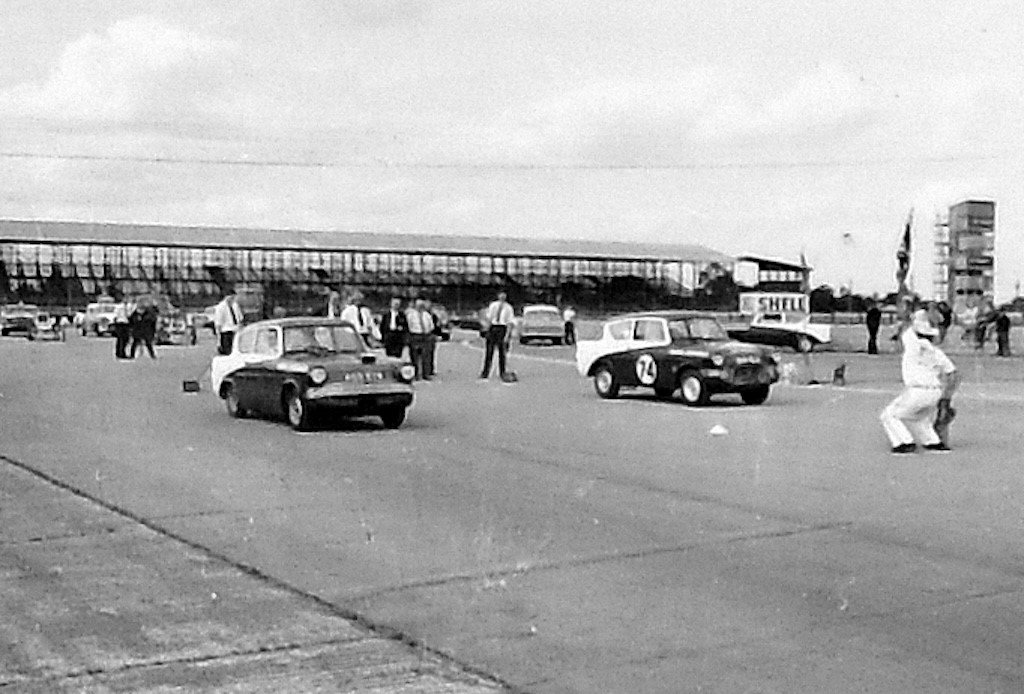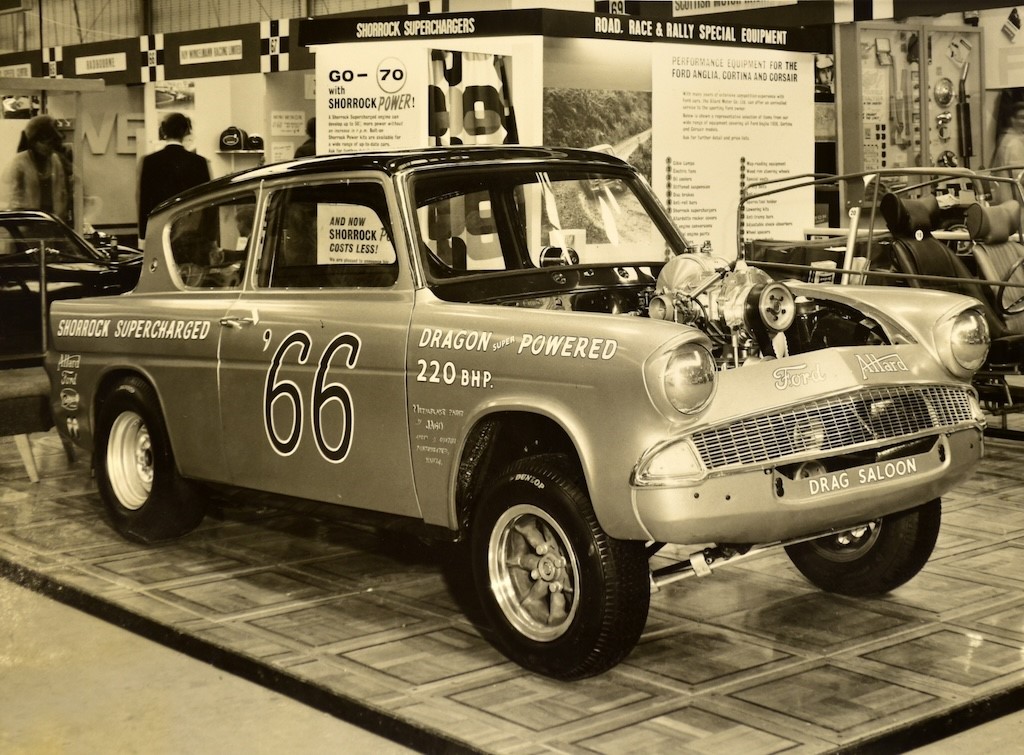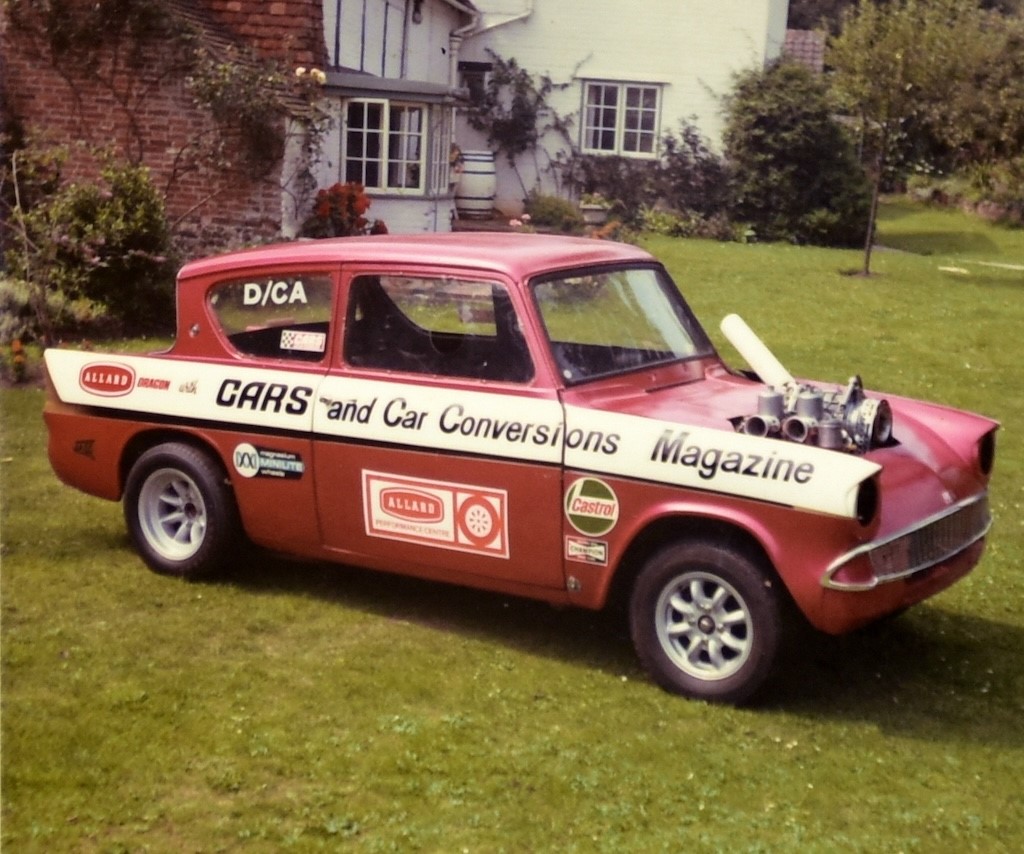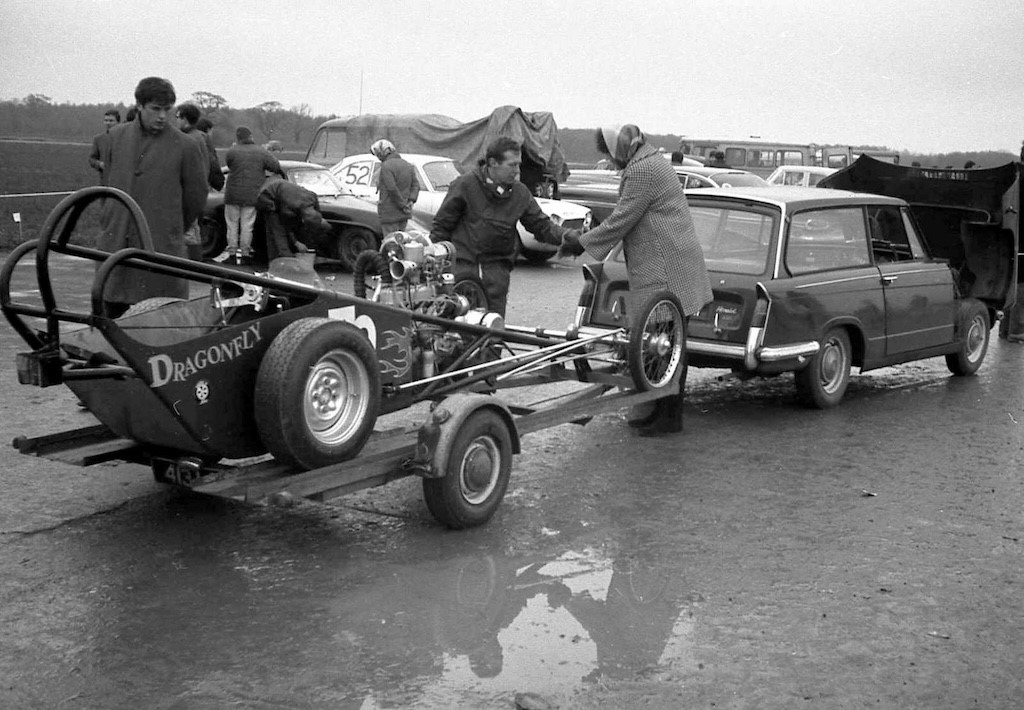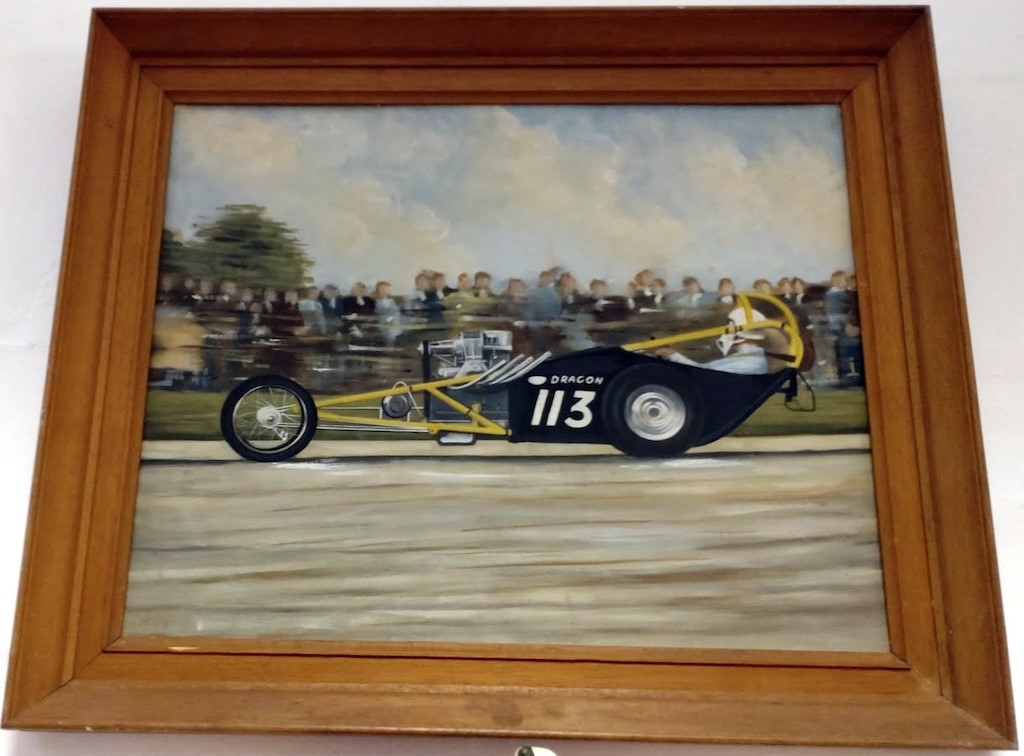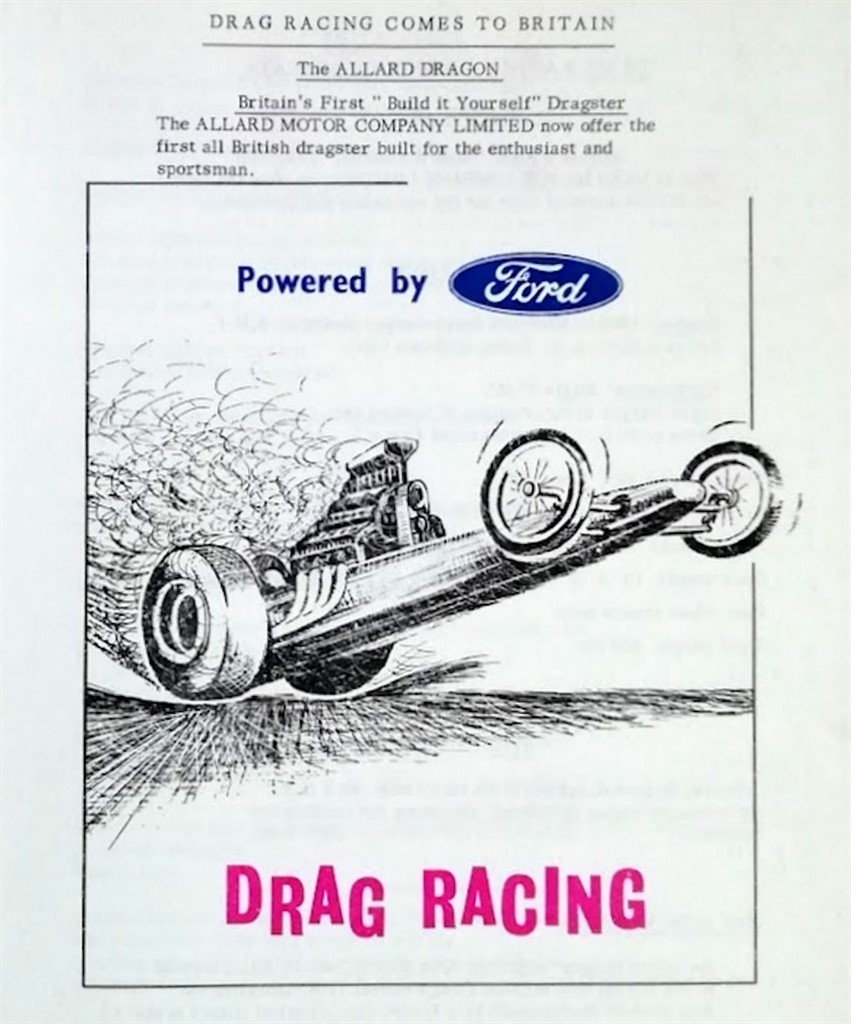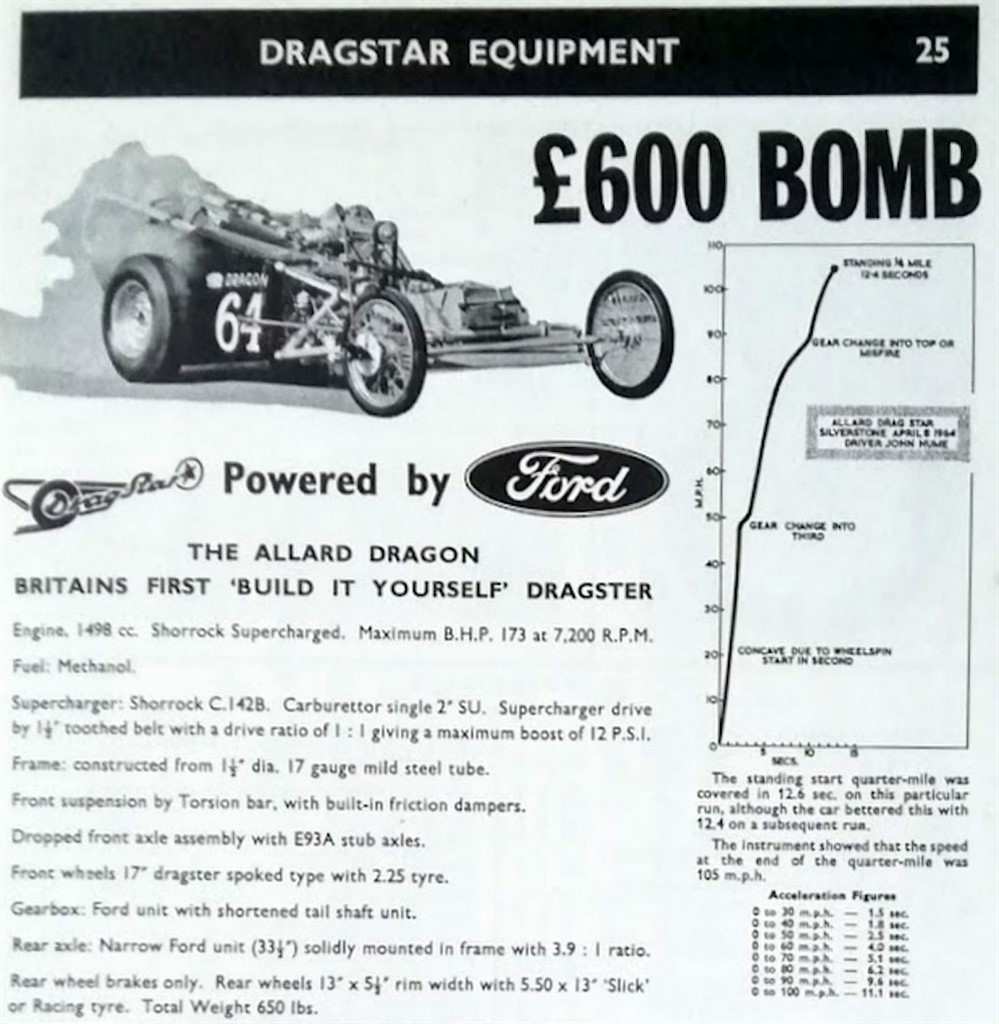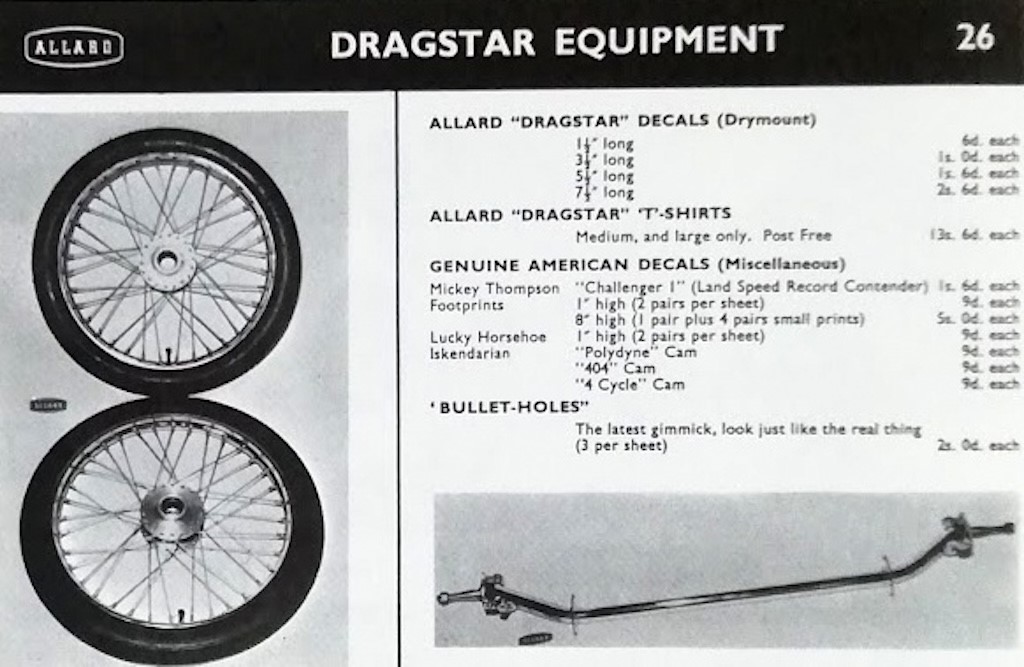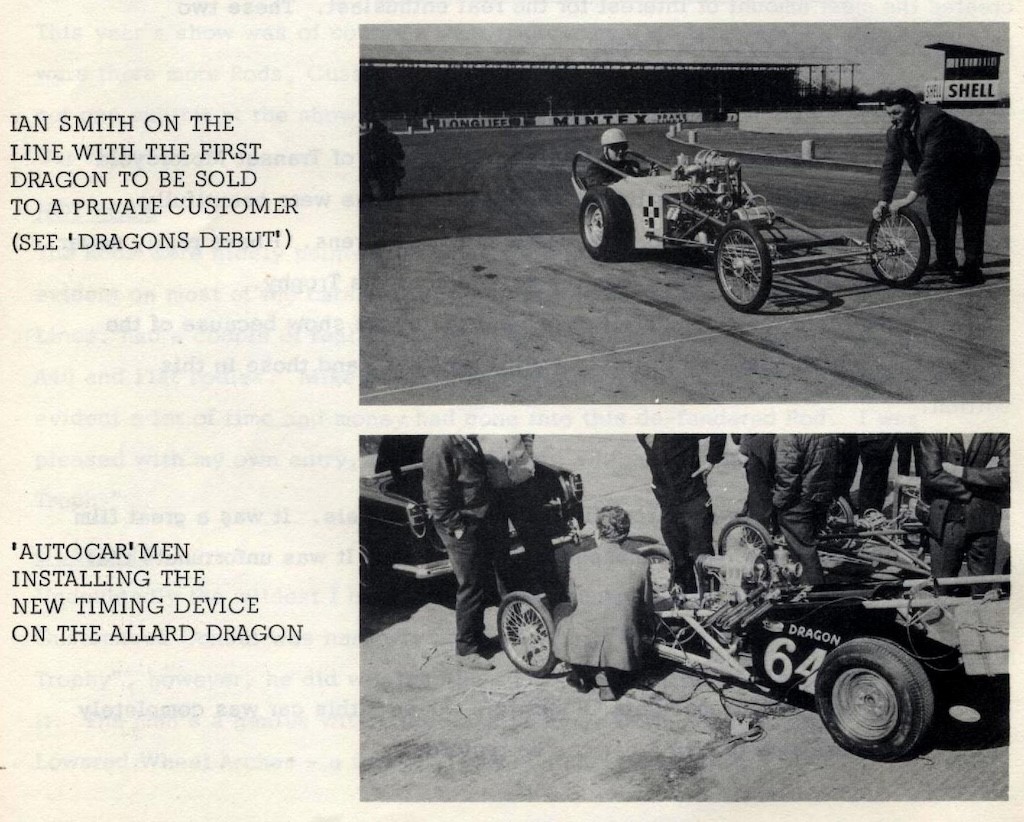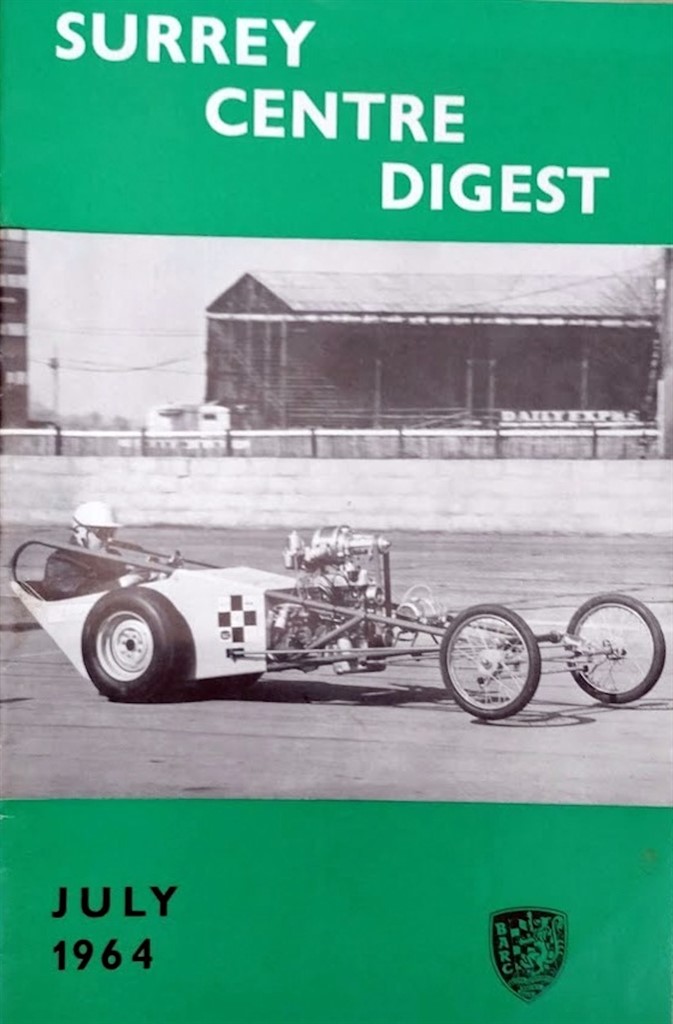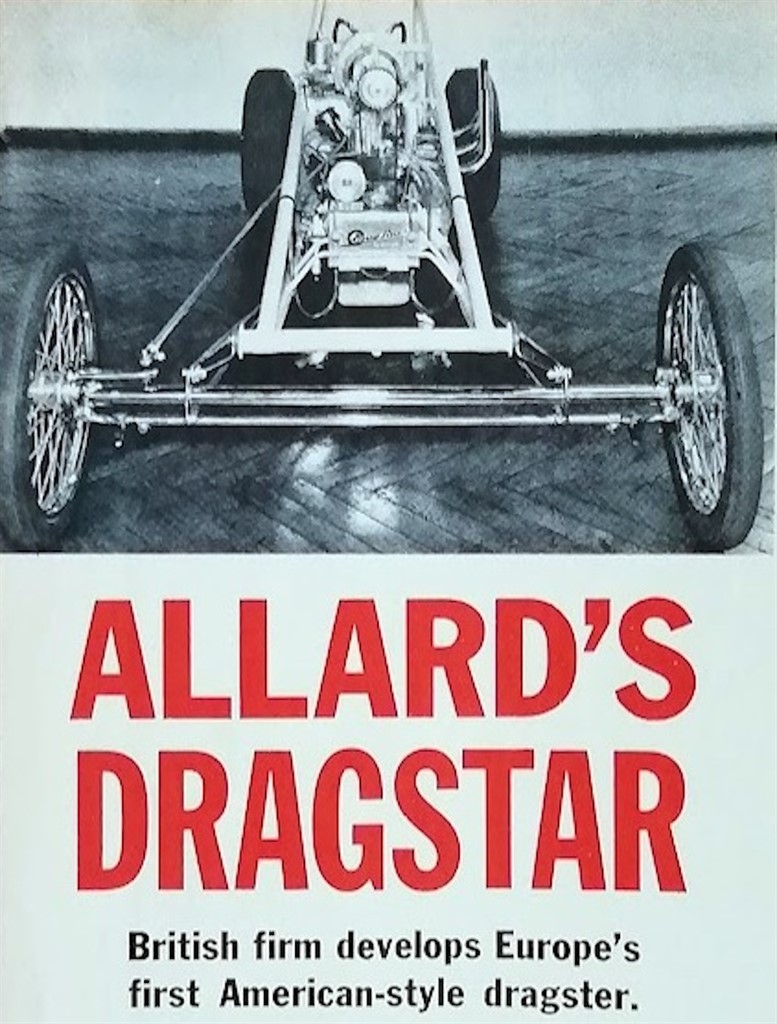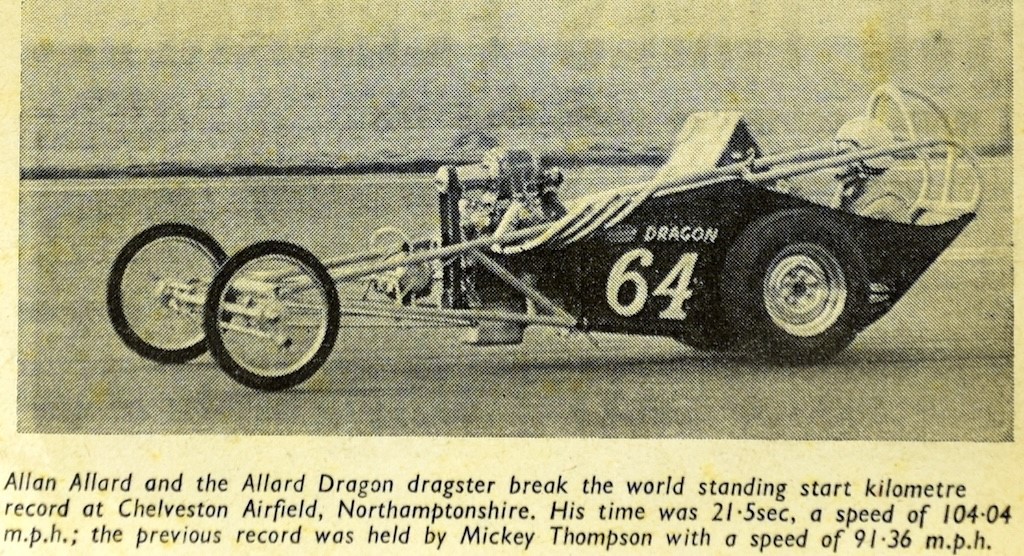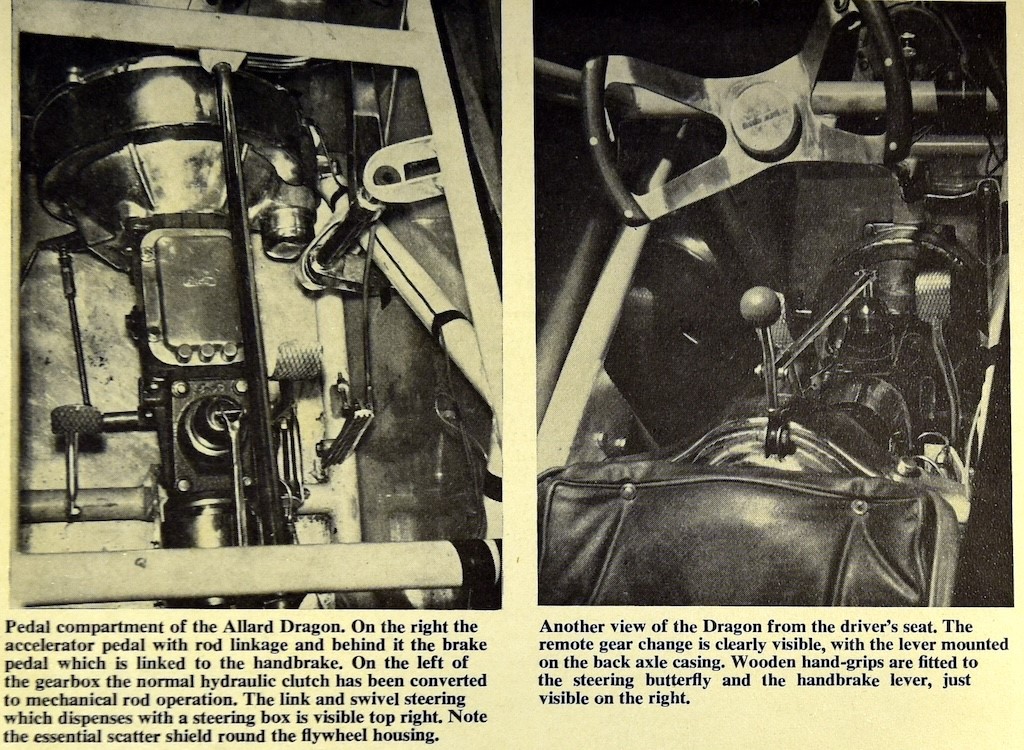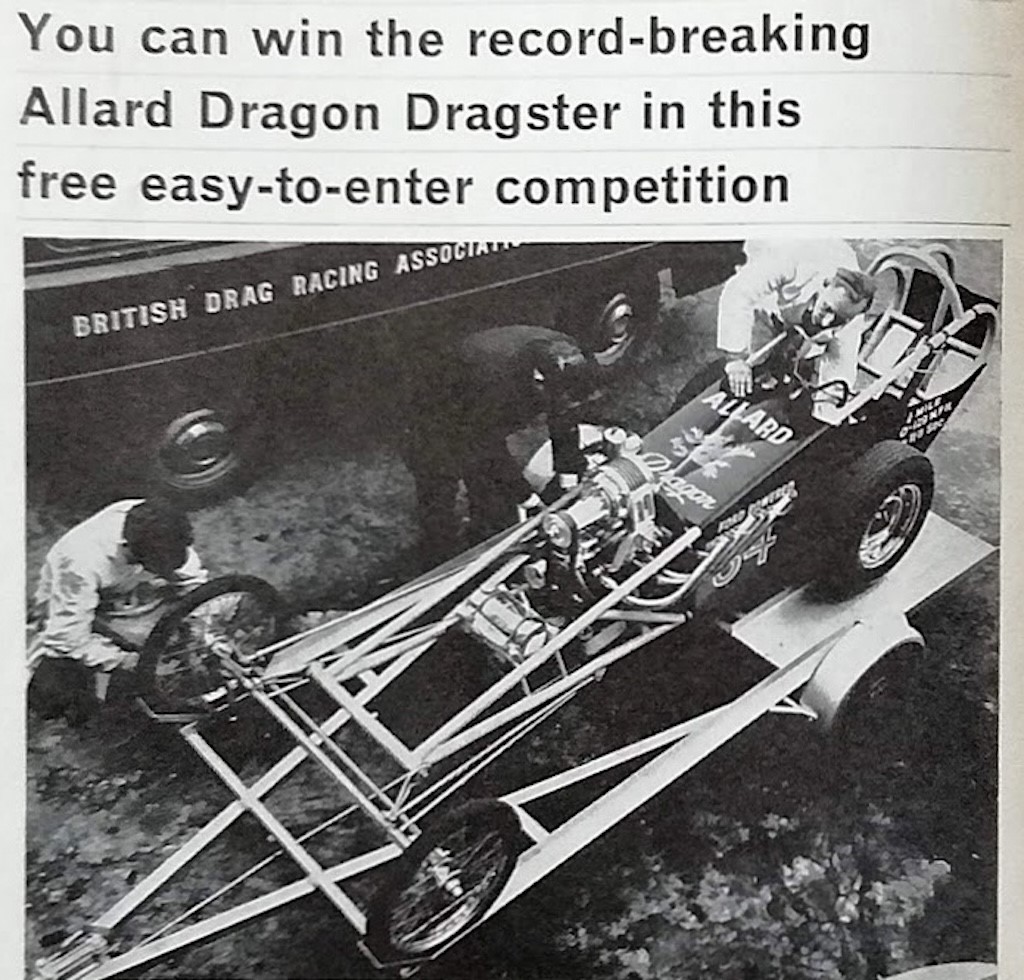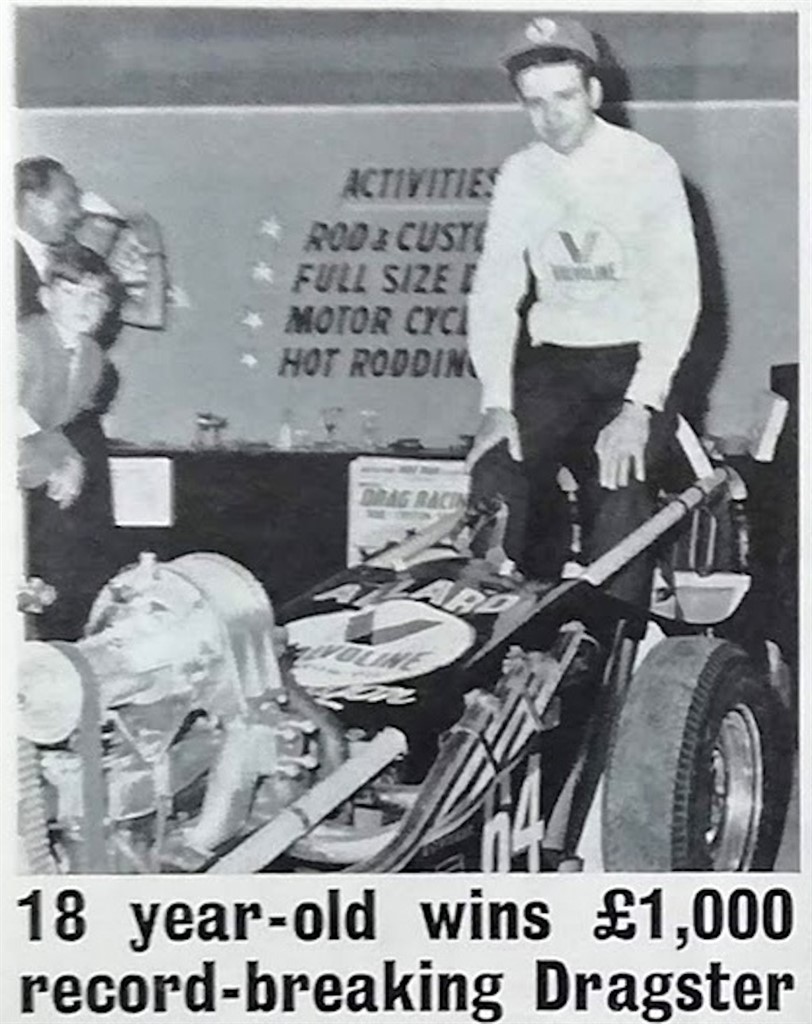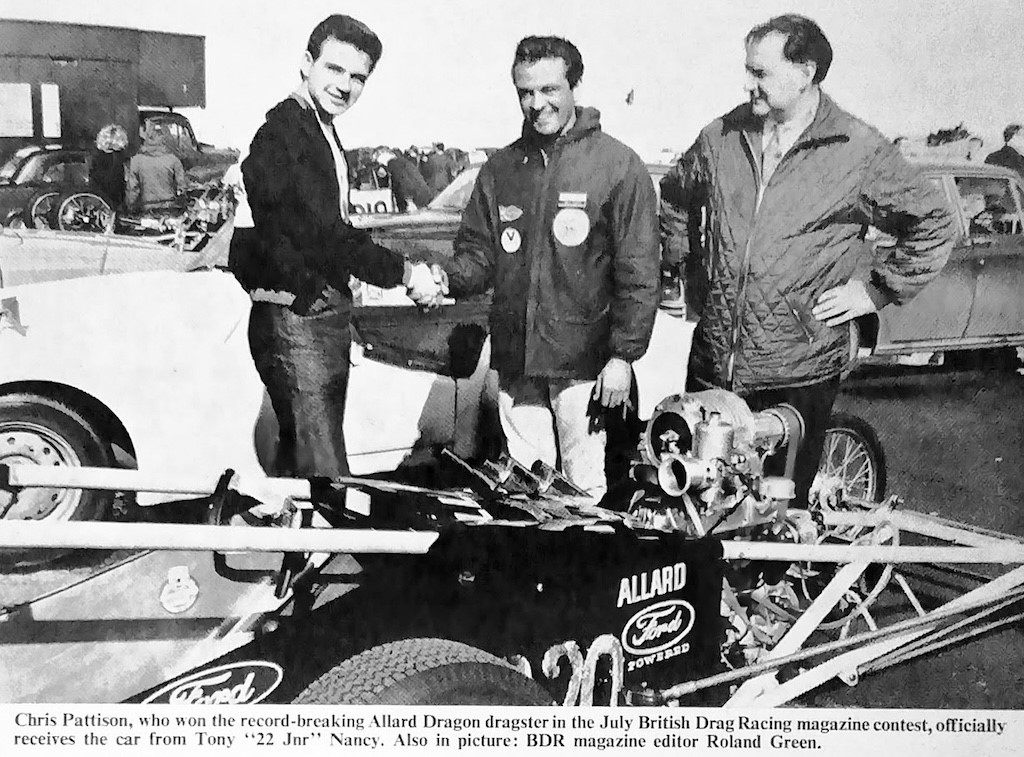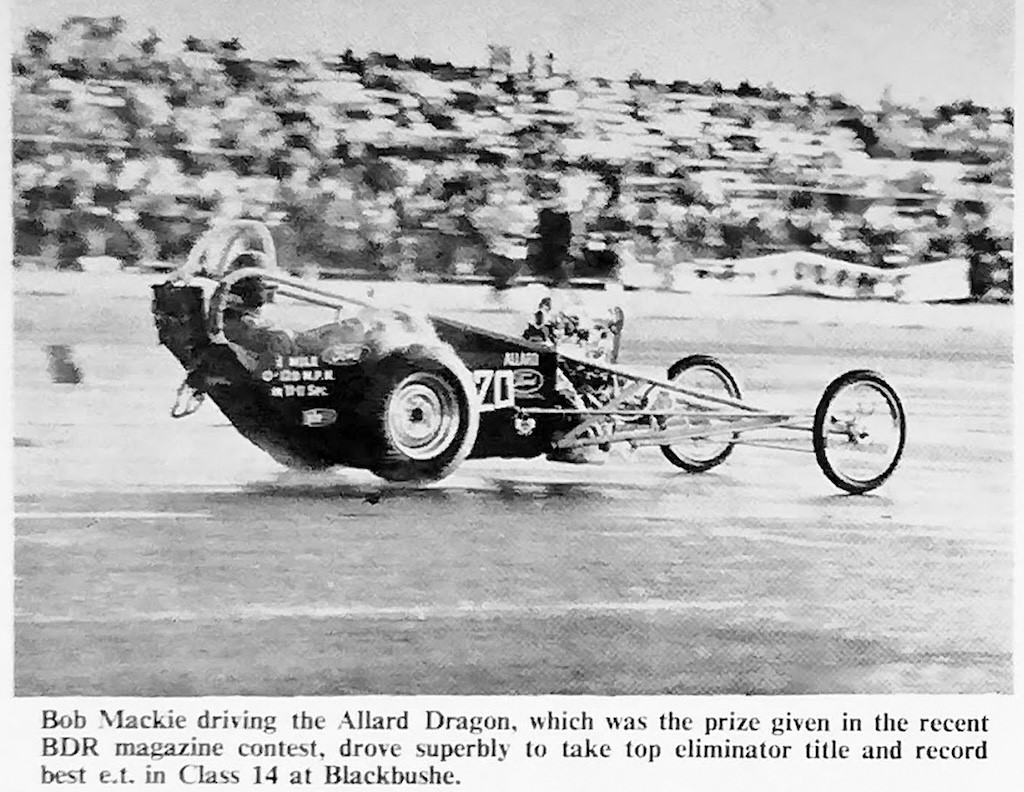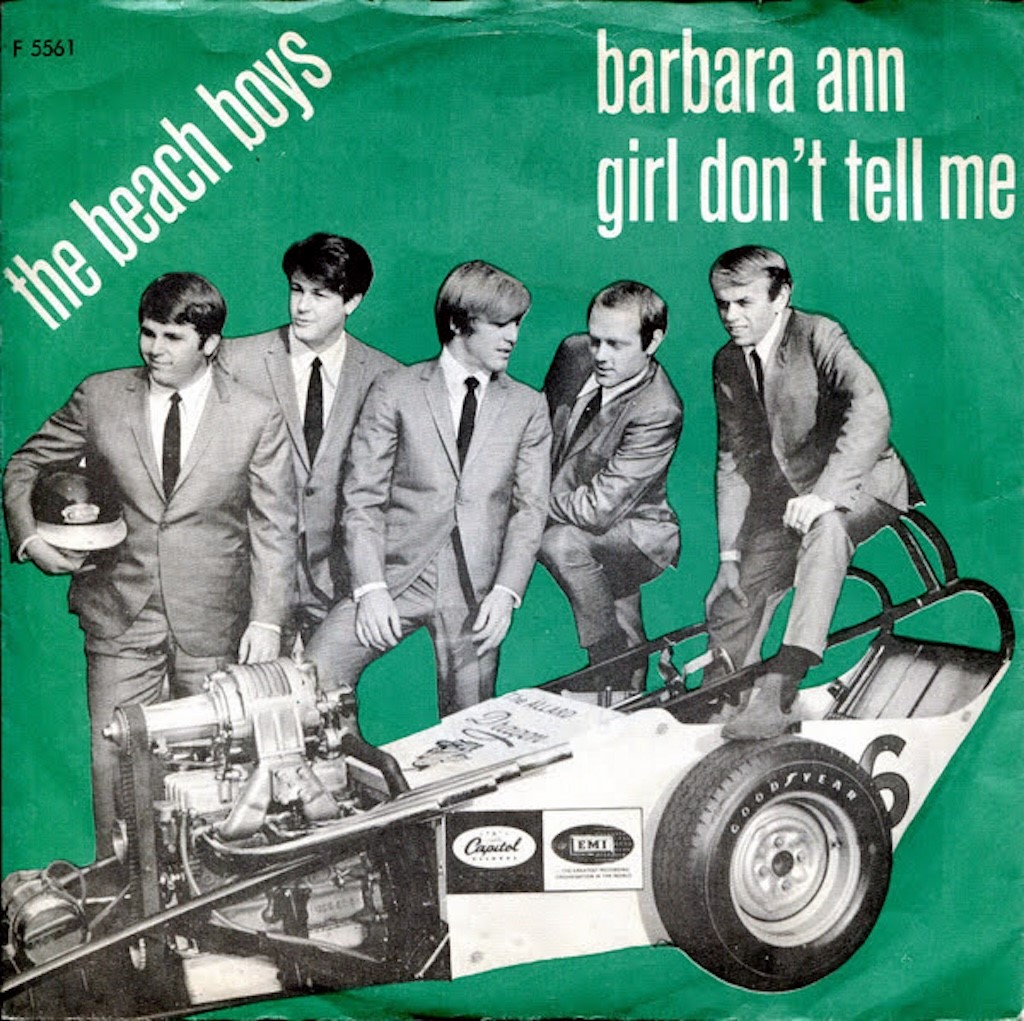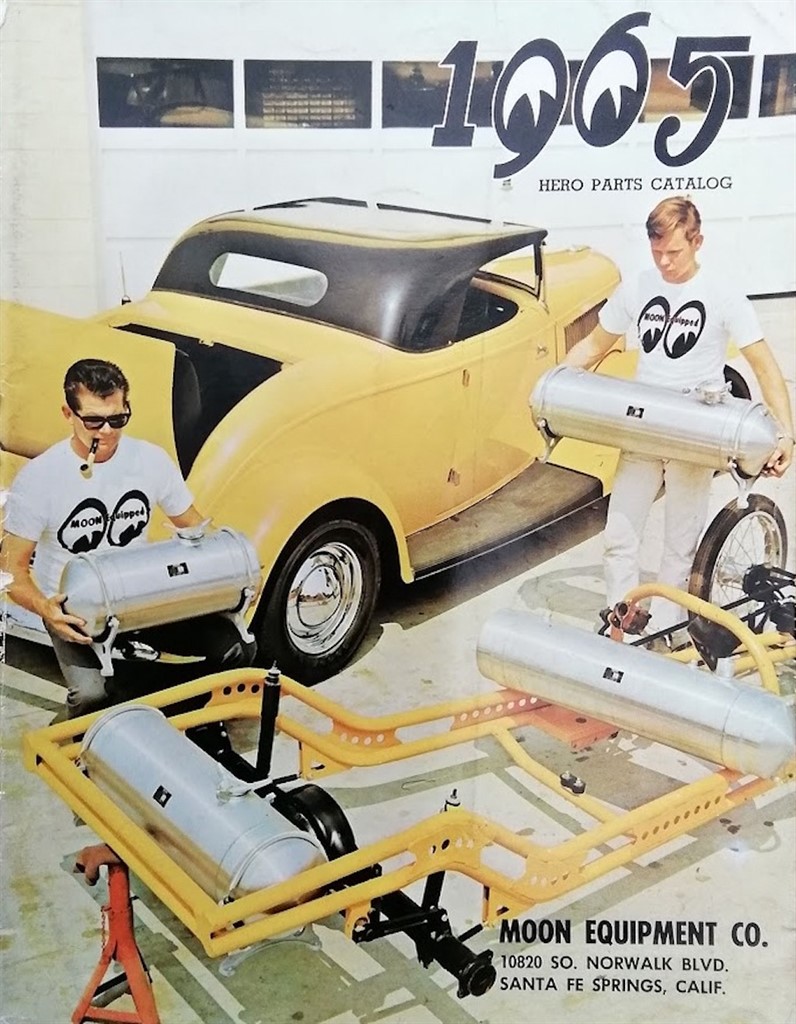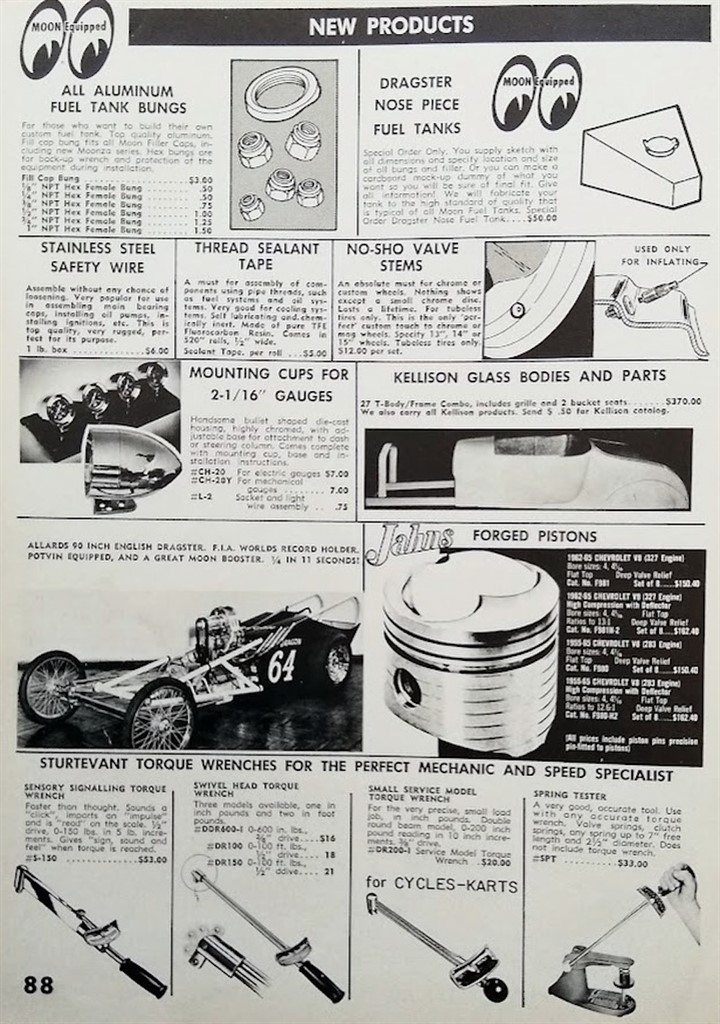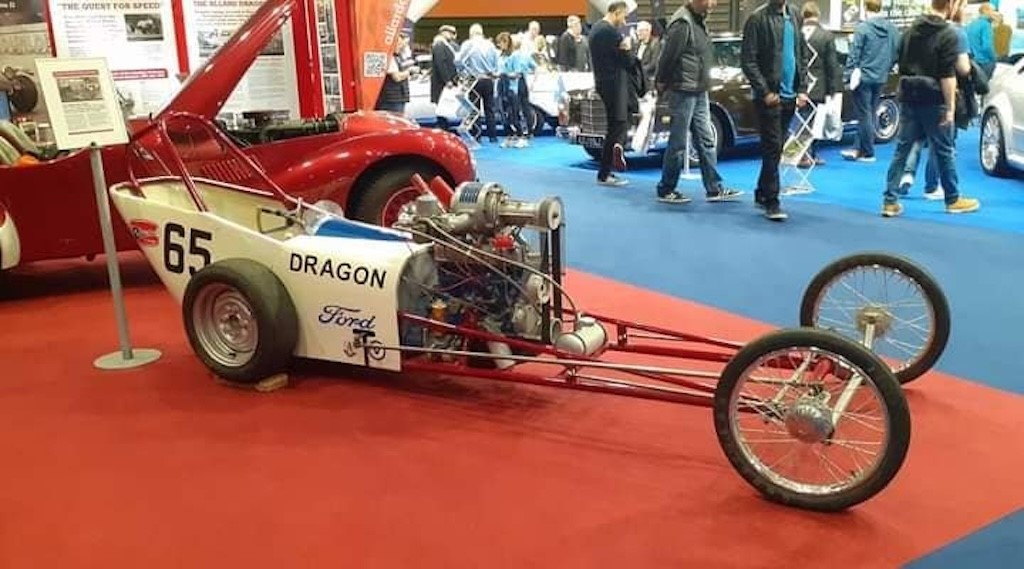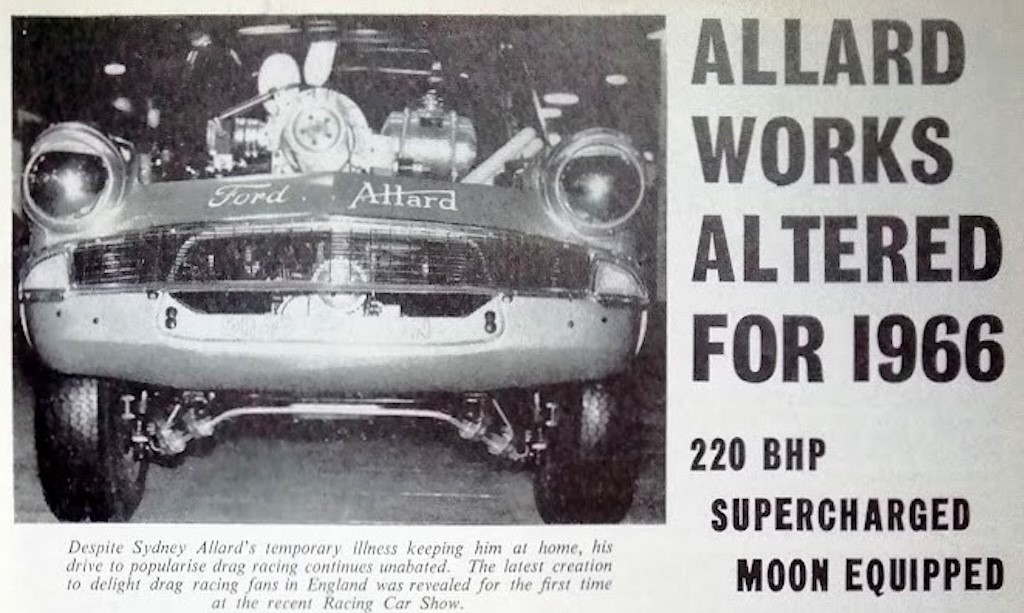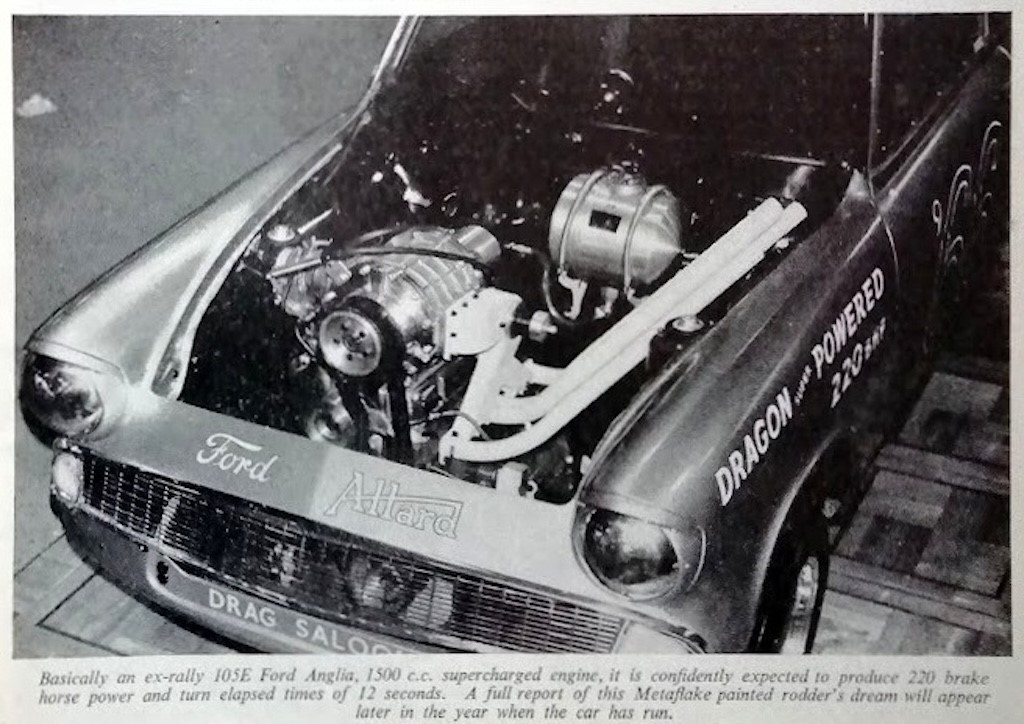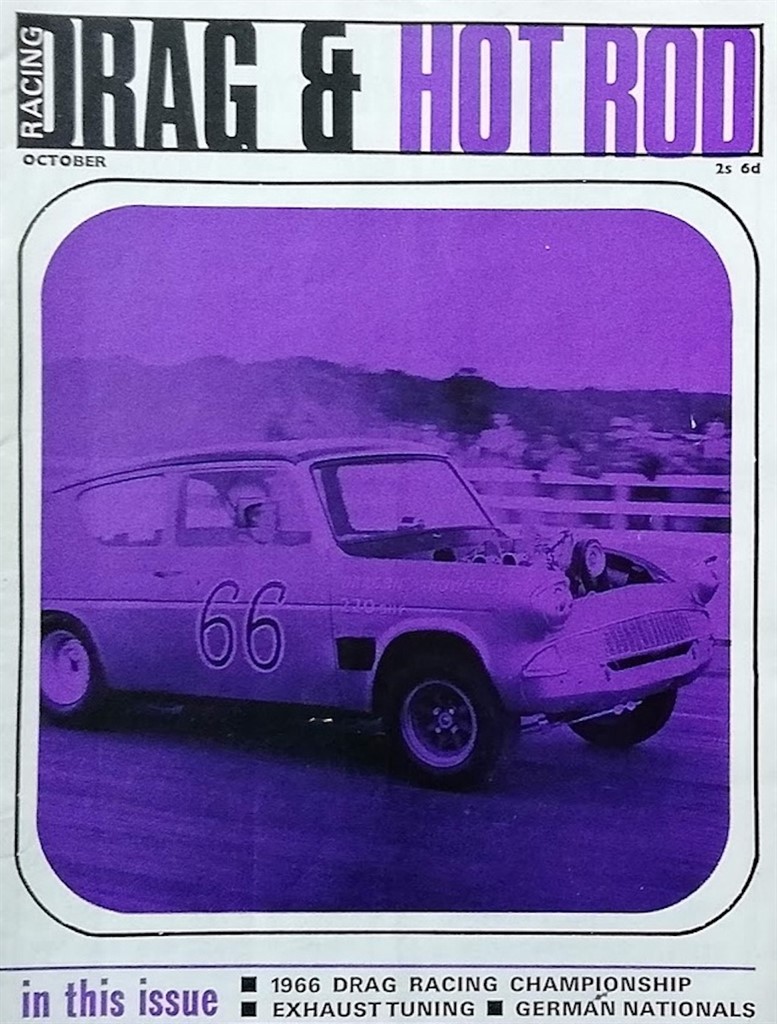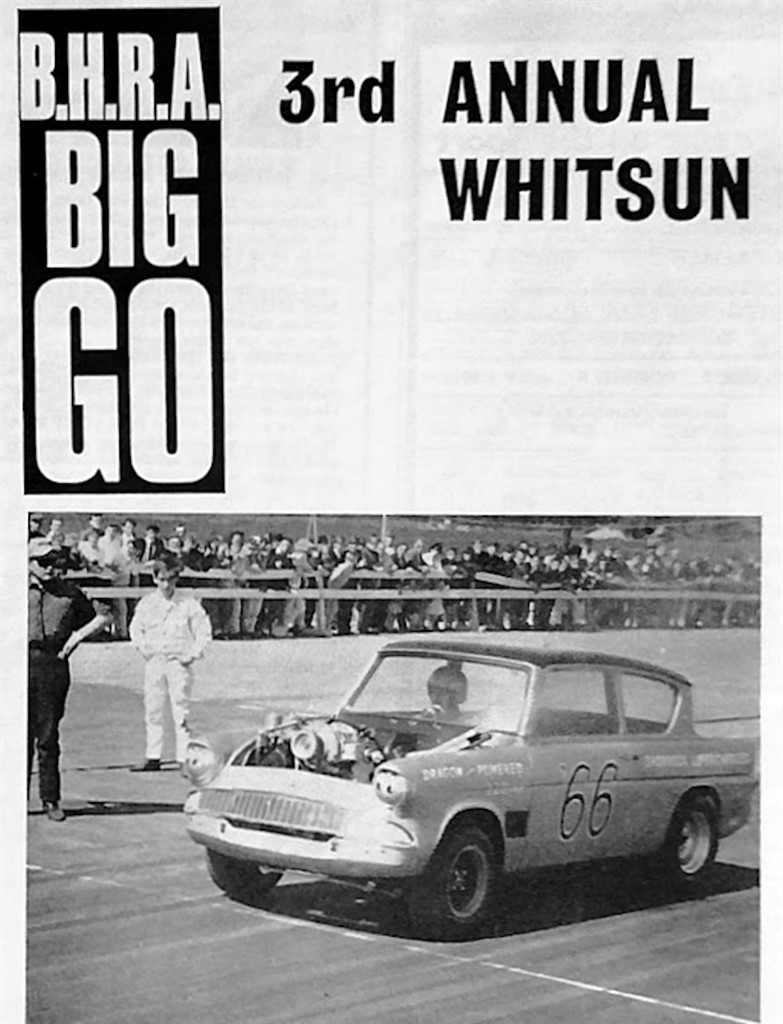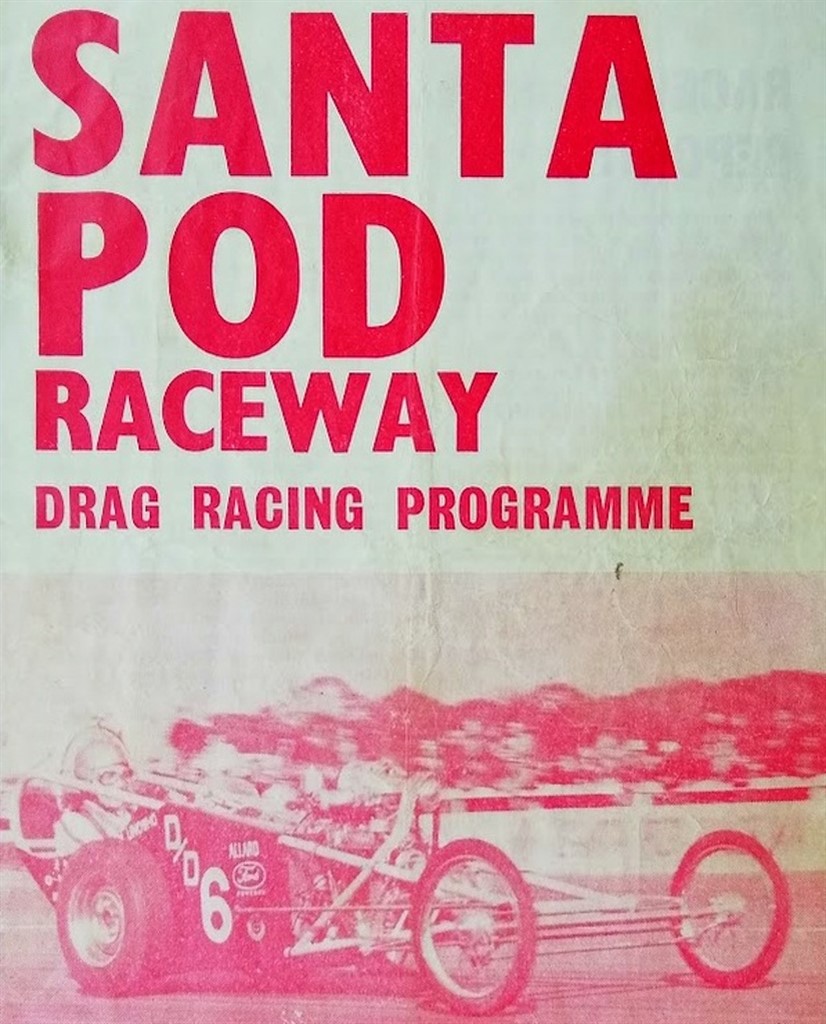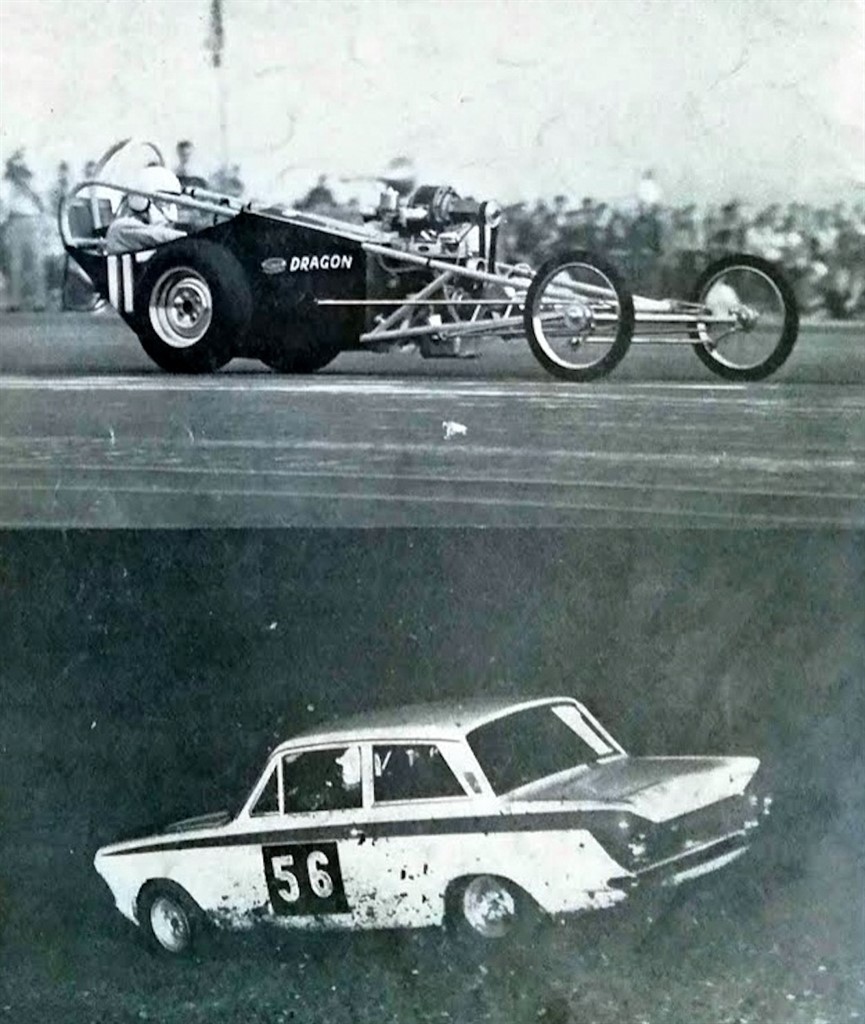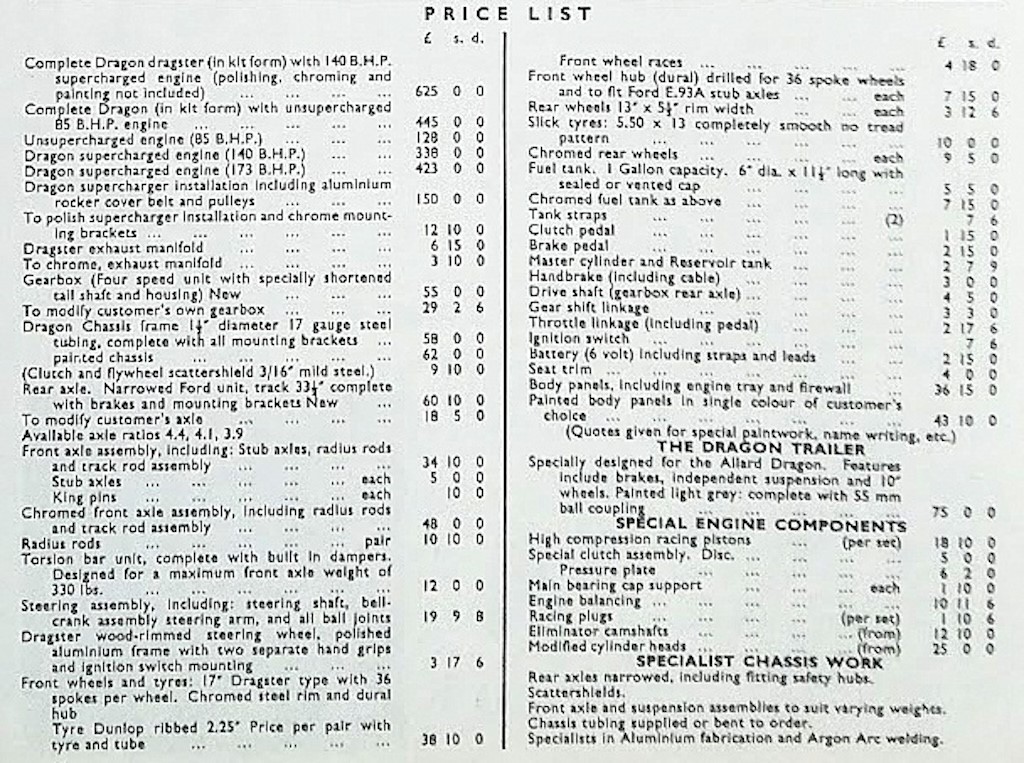Allard Dragon Story part 1
Story produced by Phil Waters has produced this story with pics added by Nick Pettitt. Published by Eurodragster.
Following on from the hugely successful 1963 visit to England by Mickey Thompson and the Mooneyes team, Sydney Allard turned his attention to designing and building an affordable dragster using readily obtainable British parts - powered by the new Ford 'Kent' engine as fitted to the Cortina GT - with the option of a Shorrock supercharger, plus a standardised chassis frame. A kind of 'Formula Ford' race car for the dragstrip if you will...although Formula Ford as a single-seater racing championship was not invented until 1967. As usual Sydney Allard - ever the innovator - was ahead of the game!
Designed by David Hooper and built by John Hume as seen in the construction photo below with Sydney Allard sitting in the driver's seat. The 'Works' Dragon made its first public appearance on the Allard Motor Company stand at the 5th Racing Car Show held at London's Olympia between 22 January and 1 February 1964.
|
|
|
|
|
|
|
|
|
|
This from the contemporary sales publicity:
DRAG RACING COMES TO BRITAIN!
The ALLARD DRAGON Britain's First "Build it Yourself" Dragster
The ALLARD MOTOR COMPANY LIMITED now offer the first all British dragster built for the enthusiast and sportsman.
SPECIFICATION
- Engine: 1498 cc Shorrock Supercharged Maximum B.H.P. 175 at 7,500 rpm (using Methanol fuel):
- Carburettor: single 2" SU was modified extensively and had an extra float chamber to handle the large flow of the methanol fuel.
- Supercharger drive by single 2" toothed belt. Drive ratio 1: 1 Maximum boost 12 psi
- Track: Front 48" Rear. 33"
- Front Suspension: Torsion bar with Built in Dampers. Front wheels: 17" dragster spoked type with 2.25 tyre
- Rear wheels: 13" x 5½" rim width with 5.50 x 13" 'Slick' type tyre. Rear wheel brakes only.
- Total weight. 650 lbs.
PRICE: Complete Dragon dragster (in kit form) with 140 B.H.P. supercharged engine (polishing, chroming and painting not included). £597.0.0d.
The next public appearances came in the spring of 1964 when a track day for the invited press took place at Silverstone. By this time a second Dragon had been built and the two cars were offered to journalists to try out and report back to their various publications.
Autocar Magazine dated 24 April 1964 published a track test under the title '£600 BOMB - Edward Eves tries the Allard Dragon' - whereby accurate timing equipment was attached to the 'works' Dragon at Silverstone on 8 April 1964.
"Clear the engine just before you take off, and don't drag the clutch. You'll find she keeps a pretty straight line, but be prepared for the hard ride and remember the steering is very high-geared.
With Sydney Allard's words ringing in my ears, I crouched in embryonic attitude behind the back axle of the Allard Dragon, engaged second gear, gave a great blast of throttle and let in the clutch.
Everything happened at once; a terrific kick in the back as the car leapt off the line; a momentary impression of rushing wind; the frozen sting of methanol on my face, and a high frequency vibro-massage from the unsprung rear wheels; then the pressing need to change gear. I scrambled for the lever between my knees and yanked it into third.
Sydney Allard thinks that, in less specialized form, the typically American sport of drag racing can become a cheap, popular pastime here. He has produced the Allard Dragon to prove it. That the Dragon is good value for money is without doubt. To produce for a mere £600 a single-seater sprint car with supercharged 1½-litre engine, which will reach 100m.p.h. in 11.1sec is an achievement indeed. Admittedly there is no rear suspension; but there is a high compression Ford Cortina engine with a Size 142 Shorrock blower driven by an internally toothed rubber belt.
Money is saved on the front wheels; they come off the lightest of lightweight motor cycles to save weight, for they do little work, with 80 per cent of the weight on the back axle; but the narrow-track, 4.4 to 1 rear axle is specially made to reduce the tendency to snake. Incidentally, locked differentials are barred in America and will be here; the Americans found long ago that a broken half-shaft with a locked diff can turn a dragster into a writhing killer. Low-profile 5.50-13in. Dunlop R6 tyres are fitted, in the absence of the "slicks," general in the States.
John Hume, who built the car and knows how to get the best out of it, drove the Dragon for the test.
The graph, plotted by an electronic recorder carried in the car, is of particular value to sprint drivers, because it shows graphically just how much time can be lost in gear changing and how the curve starts to sag as the engine passes peak torque. The standing start quarter-mile was covered in 12.6 sec on this particular run, although the car bettered this with 12.4 on a subsequent run.
The instrument showed that the speed at the end of the quarter-mile was 131 m.p.h."
Acceleration Figures
- 0 to 30 mph. - 1.5 sec
- 0 to 40 mph - 1.8 sec
- 0 to 50 mph - 2.5 sec
- 0 to 60 mph - 4.0 sec
- 0 to 70 mph - 5.1 sec
- 0 to 80 mph - 6.2 sec
- 0 to 90 mph - 9.6 sec
- 0 to 131 mph - 11.1 sec
Just as an aside it is interesting to compare the quoted £600 price of a fully specified Dragon similar to the Autocar test car with the prices of contemporary new cars as listed in the back pages of that magazine: £600 of spare cash would get you a brand-new Austin Mini-Cooper for £568, a Ford Cortina two-door deluxe for £597 or a Lotus Super Seven in self-assembly kit form for £585. Take your pick!
|
|
|
|
|
|
|
Motor Racing magazine - the 'Official Organ of the British Racing & Sports Car Club' also sent Associate Editor John Blunsden to try the Dragon at Silverstone. His two-page track test report published in the June 1964 issue uses the times and speeds obtained by The Autocar magazine 'which I am sure they will not object to me quoting'.
"From the sidelines, watching John Hume in the works model I had just used, and lan Smith in his, dragging had looked a pretty terrifying sport, but in fact it had proved most exhilarating, and seemed a lot less dangerous than it looked. I trundled back to base, disappointed that I hadn't cleared the engine properly before going off, but heartened that I could have another go when the other candidates had had their turn.
Unfortunately, it just wasn't my day. Originally, I had climbed aboard the gleaming yellow and red Ian Smith car, which seemed to fit me a real treat, only to discover that the clutch had come adrift internally as I was about to be pushed off. I had then transferred to the works car, which is two inches narrower, and has an extremely high front lip to the driving seat. This means that leg movement above the knees is restricted, and I found that my legs were tending to dangle in mid-air when not firmly wedged against the pedals. Then, after one other driver had had a run, a third journalist hopped on board, and finished up half way down the course with an undertray full of clutch facing fragments. Meanwhile, frantic efforts were being made to get the Smith car going again, and the job of 'engine out, clutch down, clutch strip, clutch reassembly, engine in and engine run' was completed in just over an hour, demonstrating the extreme accessibility of the Dragon. But time ran out, and I was unable to get in a second run."
"These are all part of the drag world. An exciting sport for participants, and surely for spectators as well. One of the attractions is that it is so different from other types of motoring sport, with its own rules, its simple course requirements, and comparatively speaking its low cost for a speed sport.
The Dragstar Dragon sells in kit form for £597 (that does not include polishing, chroming or painting), or if you take it with an unblown Cortina engine (developing 85 horsepower instead of the 140 provided with the blower) the cost is £445. And just about everything which goes into it can be bought separately, right down to the wood-rimmed steering wheel with its mounting for an ignition cut-out switch (which is quite easy to trip unintentionally when you are 'raw' to it all!).
The sprinter is built to comply with new regulations which have been drawn up by the RAC for drag racing in this country. It has a total weight of 650 pounds, most of which is carried on the 13-inch rear wheels (5½ inch rims) which, in the absence of slicks, was fitted with normal treaded Dunlop racing tyres for the try out, and these appeared to be perfectly adequate. The 17-inch front wheels (with 24-inch tyres) have no brakes but the Dragon has very reasonable stopping power through its rear brakes, to which a cable operated handbrake is attached for holding the dragster on the start line.
The main chassis frame is in 1½ inch diameter 17-gauge steel tubing, and the rear axle is a specially narrowed Ford unit (choice of three ratios) to give a 33½ inch track, compared with the 48-inch track of the front wheels. The blower, which has a maximum boost of 12 psi, is driven through an internally toothed rubber belt from the front of the crankshaft.
Ian Smith, no stranger to the not-so-gentle art of sprinting, seems to have captured the Transatlantic drag atmosphere, and has decorated his Dragon with motifs and symbols depicting his various commercial activities. The whole thing is immaculately turned out, and rightly so, because this is a type of sport which is the very essence of showmanship.
It is interesting to learn that America is intrigued by this British effort to develop what has hitherto been very much a national sport, and a couple of Dragons have been bought by drag enthusiasts in the States."
The above paragraphs do contain a couple of intriguing quotes - given that we know that apparently only two Mk1 Dragons were ever built. Firstly, proof that the 'works' machine was some two inches narrower than the other one, but more especially that 'a couple of Dragons have been bought by drag enthusiasts in the States'. A mystery if ever there was one, and yet to be proven with hard evidence. Certainly, there was some interest as my personal copy of the dedicated Allard Dragon catalogue, a four-page A4 information and price list, was sourced from the US. It is also interesting to note that the 1965 edition of the Mooneyes catalog contains a photo and brief caption of the works Dragon on the ' New Products' page.
Following on from the Silverstone event another track day was held at Blackbushe Aerodrome for the benefit of Small Car Magazine who brought along 20-year-old Dutch racing driver Liane Engeman. Southern Television also covered the event with some great footage presented by a young Dickie Davies. Catch it in this YouTube video by clicking here.
|
|
|
"Remember SMALL CAR'S May fast girl?
For this special summertime getaway issue we took lovely Dutch born blonde Liane Engeman to Berkshire's Blackbushe aerodrome for a try out in the sensational £600 Allard Dragstar Dragon. Southern Television was there to share the fun with thousands of lucky viewers. And now here's Liane herself to show you how she did it - did it so well, incidentally, that sprint king Syd Allard himself was amazed."
'OH, NO!' I KEPT TELLING myself. 'Oh, no - not this!' It was my first ride in a dragster and I was hating it. Luckily the experience didn't last.
That's the whole point. Dragsters are like time bombs. What they do they do well, but not for long. The Allard Dragstar Dragon – to give it its pukka handle - is almost certainly one of the world's smallest, mildest, slowest, cheapest dragsters. Yet it won't run five minutes without boiling all its water away. It burns neat methanol at the cheerfully extravagant rate of two mpg. And it will get from a standing start to 60 mph in just four seconds.
These things are complementary. The Dragon I drove had only а superficially tweaked-up Ford Cortina GT engine, albeit with a ginormous Shorrock supercharger poised on its rocker cover huffing in methanol + air = Combustible Mixture and puffing out something like 120 bhp. My last 120 hp car took about four times as long to get to 60 mph. Ergo, there must be a secret. There is. Lack of weight."
"They're waving from the pits. Time for that first run. In between snatches of trying to decide whether the rattling noise in the background is the big-ends or your teeth, you grope for third and head slowly for the line. There's the strip stretching away like a great black carpet into the middle-distance. There's Allard PRO Gerry Belton hammering down to the other end in his big white Corsair. There's Syd Allard and the boys waving and urging from the side-lines. 'Get on with it!' You press down on the clutch pedal, tramp on the throttle .. God, the noise! You line up the end of the straight and let go.
Wham! Suddenly the whole world is on fire. The wind rips at your face. Molten rubber swirls in great pools beside you as the giant tyres scrabble for a grip. The nose comes up, the tail down as the back of the seat gouges a trench in your spine. Your stomach breaks loose and deserts you permanently. Your ears crackle, as in a jet-plane landing. Your surroundings blend into a grey-green blur. The blower's banshee shriek reaches a crescendo: time to change.
A pause. Bang! You're in top, and it starts again. 80 ... 90 ... more, much more. Steering is impossible now. Great jarring crashes come through as you hurtle over those tiny surface imperfections. Suppose you lose control? The wind howls, the exhaust bellows in your ear...then agony! Hot water whips into your face - what if it's oil? Terrified, out of breath, half blind, you back off in time to stop for the end of the strip.
Never again! It's like sitting on the front of a blunt bullet. Like getting trapped in a runaway lift. Like one of those nightmares when you find yourself on Battersea's Big Dipper with nothing to hang on to and a great yawning chasm out in front. No! Never, never again. And of course you go back. You have to, and in a dragster there's no other way but fast. Alternate bursts of paralysing acceleration and anxious overrun return you, stuck in top gear, to the waiting group. Your eyes are streaming, your crash hat is crooked, your ears still buzz and crackle and vaguely you wish you could be sick. Would it be very different if this little knot of watchers were a cheering crowd - if Syd Allard had a laurel wreath in his hands instead of a petrol-can?"
Further publicity can be found in the September 1964 issue of the US magazine Modern Rod which ran a four-page feature on the new Allard Dragon:
"ALLARD'S DRAGSTAR”
British firm develops Europe's first American-style dragster.
The fourth rung of the ladder leading up to internationalization of the sport of drag racing has recently been installed by Sydney Allard of London, England. The first rung, of course, also the work of Mr. Allard, was the building of the first British dragster in 1961. The second was the exhibition meets staged in a total of four spots in England and involving the Revellsponsored Mooneyes machine, Mickey Thompson, and Sydney Allard. These meets took place in September of 1963. Still in the ladder analogy, the third rung is the first International Drag Festival, to be held in England in September of 1964. As you already know, no doubt, this will consist of five meets, scheduled for the period between September 10th and 27th. Around thirty of the fastest machines in the world are expected to take part, including cars and cycles. European countries other than England are expected to enter competitors in these events, and even New Zealand and Australia have expressed deep interest in the proceedings. Who knows how big this thing could get to be?
But what about the fourth rung of the ladder? Well, that is represented by Sydney Allard's DragStar Dragon, the first British-produced "true American style... 'slingshot." The Dragon, according to Mr. Allard, was developed as a result of concentrated experience with the car he introduced in 1961".
Modern Rod quoted the list price of a Dragon kit in the USA as $1800.
Some interesting facts and figures on the works Dragon from British Drag Racing Magazine: "The car was run for the first time before the motoring press at Silverstone on 8th April 1964, and produced a best time of 12.47 secs.
Two months later, Alan Allard took the Dragon to Chelveston airfield in Northampton to attack the international Class "F" standing start kilo record held by American Mickey Thompson at 91.36 mph. The Dragon promptly set a mean average of 104.04 mph. for the distance in 21.50 secs. At the same time, Allard established the national standing start quarter-mile record in 11.54 secs.
In early September, the Dragon was demonstrated in front of 125,000 spectators during the Italian Grand Prix at Monza, Italy. Later that month, Alan Allard entered the car in the 1st British International Drag Festival and took top British honours as well as setting the car best time and speed to that date of 11.26 secs, 129 mph.
|
|
|
|
|
|
|
Meanwhile on 2 November 1964 the second Dragon starred with The Beach Boys in a photo shoot outside EMI House in Manchester Square, London. The boys were in the UK to promote their latest single 'When I Grow Up To Be A Man'...
There are plenty of photographs of this event available to view online, one of which was later used as sleeve artwork for the single 'Barbara Ann' - first released in December 1965.
Some of the other published Beach Boys photos have typically inane captions such as this one:
"The Beach Boys really felt at home in London on Monday when they found this dragster outside E.M.I. House in Manchester Square. The Allard-built machine with a Cortina engine does a ton in as many seconds as it takes a conventional car to go through the gears. All five Beach Boys are experts in dragsters, but they weren't allowed to zoom it round Manchester Square.
|
|
|
|
|
In February, 1965, the Dragon flew, under Ford Motor Company sponsorship, to the
National Hot Rod Association's Winternationals in California - the first British dragster to run on American soil. Driver was Doug Church who had raced his Porshe powered Modern Specialist Dragster at the 1964 Drag Festivals. The Dragon was also displayed at a show.
From the States the car was shipped straight to Stockholm for the leading Swedish Auto Show, and arrived back at the Clapham works of the Allard Motor Company having travelled some 18,000 miles in a period of 16 months."
|
|
|
May 1965 saw the launch of British Drag Racing Magazine as a proper publication complete with colour cover photos. This replaced the previous typed foolscap newsletter format for this 'Official Journal of the British Drag Racing Association'. The new magazine had 'agreed to purchase from the Allard Motor Company the record-breaking Dragon dragster as a prize to the person who contributes the best workable ideas and suggestions in our first ever contest'. The car became available because Alan Allard, who drove this machine at the 64 Dragfest, would be taking on the driving duties of the revised Allard Chrysler dragster - now rebuilt with an up-to-date slingshot frame.
Page 2 of the June 1965 issue contained the following ad...
"WIN the ‘Works’ ALLARD 'DRAGON' DRAGSTER!
You can win Britain's most successful dragster ever - the works "Dragon" dragster which was driven with such outstanding success by Allan Allard during the 1st British International Drag Festival.
More than £1,000 has gone into this famous Allard "mobile test bench". The "Dragon" can be yours in an easy-to-win competition, full details of which will be given in the June issue of British Drag Racing Magazine.
- 1964 Racing Car Show Exhibit
- Best British Car, 1964 Drag Festival
Holder International Class "F" Standing Start Kilo Record
(previously held by Mickey Thompson.)
Holder British National Class "F" Standing Start 1/4 Mile Record.
Dragster Demonstration Team, Monza Autodrome, Italy, September 1964.
- First British Dragster to visit America, appearing 1964 N.H.R.A. Auto Show and Winternationals Pomona, California.
- Powered by 160 b.h.p. Shorrock Supercharged 1,500 c.c. Cortina G.T. Engine.
In your own interests place an order for British Drag Racing Magazine with your newsagent TODAY!"
All the prospective winner had to do was "Tell us in which way you think BRITISH DRAG RACING could be improved", along with reasons why and order of preference of suggested features. Easy peasy...! The lucky winner was to be presented with their prize 'by a drag racing personality on the morning of the first day of the 2nd British International Drag Festival'.
The September issue of British Drag Racing Magazine announced the winner:
"WIN the ‘Works’ ALLARD 'DRAGON' DRAGSTER!
The B.D.R.M. June contest brought in 478 entries, the majority of which were of a very high standard. For a whole day the panel deliberated on a final few. Eventually it was the unanimous decision that the record-breaking Allard Dragon Dragster and trailer should be awarded to:
C. G. Pattison, High Wycombe, Bucks.
Mr. Pattison will receive the Dragster from top American Drag Racing driver Tony Nancy on the morning of the International Festival at Blackbushe, Camberley, Surrey, on September 25th".
Chris acknowledged the win with this letter that was published in the October 1965 issue of British Drag Racing Magazine:
"I find it hard to express and describe my feelings even two days after receiving your shattering telegram. I am still so thrilled I find it difficult to accept the fact that I have indeed actually won your magazine's competition.
However, I can only add my grateful thanks for all that you have done for me, particularly when I was at the Model Exhibition, a day I shall certainly have cause to remember!
I can hardly contain my impatience for the forthcoming Dragfest to begin and the commencement of the real excitement.
Once more my grateful thanks.
Yours sincerely,
Chris Pattison, HIGH WYCOMBE, BUCKS."
Chris will be presented with the Allard Dragon by Tony Nancy during the morning of the first day of the Festival.
British Drag Racing Magazine November 1965 published a photo of Chris being presented with the Dragon by Tony Nancy, accompanied by the magazine's editor Roland Green.
Unfortunately, that turned out to be the final edition of the magazine as it became an unfortunate casualty of the huge financial losses incurred by the 2nd British International Drag Festival due to appalling weather conditions and the resultant loss of spectator income.
Backtracking slightly to January 1965 and the Dragon Mk2 dragster was introduced on the Allard stand at the Racing Car Show at Olympia where it was exhibited as a chassis frame fitted with supercharged Ford engine and rear axle. Interestingly the official Allard catalogue still showed photographs of the Mk1 Dragon in the 1966 edition. The Dragon Ford supercharged engine was also available as a complete unit 'ready to fit into Lotus 22 frame with Hewland gearbox'. This version fitted to a single seater racing car enjoyed considerable success in the British Hill Climb Championship of 1965:
|
|
|
|
COMPETITION SUCCESSES
Allard Dragon powered Dragster, fastest 1500 cc sprint vehicle in the world. Class F & mile International record holder and Kilometer world record holder.
British hill climb championship 1965: 3rd Position Peter Meldrum Lotus Dragon, 7th position Bryan Brown Lotus Dragon.
Many B.T.D.'s were set and course records broken during the season.
In the sports racing category, many fine wins were made by John Barnes in his Dragon powered Elva."
Not a great deal is known about the Mk2 machines. One appeared at the 2nd Dragfest held in September 1965 driven by Colin Glass. That car had a two litre Bristol engine rather than the usual Ford 1500cc units of the Mk1 Dragons. This meant that the Mk2 car was in the up to 2500cc class rather than the two Mk1 machines which were categorised in the 25005000cc class by virtue of being supercharged. Whether the Colin Glass car was the one exhibited at Olympia or was another one is not yet known.
Around nine years ago a bare Dragon Mk2 chassis was discovered by Roger Hayes, a member of the Allard Owners Club and was subsequently restored to a complete car with Ford supercharged engine. It has been exhibited on the Allard Owners Club stand at the NEC Classic Car Show a couple of times. The owners say that there were two Mk2 Dragons built - the Bristol powered one and a Ford powered one which possibly may be the 1965 show car chassis. Meanwhile the 'works' Mk1 Dragon is missing since the late 1960s but happily the other Mk1 - now named 'Avanti' - survives in the custodianship of Alan Smith.
|
|
|
|
|
1966
Once again the Allard Motor Company used the January Racing Car Show to debut another drag racing machine. This time it was a stripped down and jacked up Ford Anglia 105e saloon car - fitted with a supercharged 1500cc Ford engine similar to that of the works Dragon - hence the altered Anglia became known as the Dragoon, as in Drag Saloon. Alan Allard would drive the car.
|
|
|
Motor Racing Show. Allard Archives.
|
|
|
The Allard Motor Company had had previous success with the modified Anglia Allardettes in rallying and indeed at Silverstone back in 1963 two Allardettes - driven by Sydney Allard and Dante Duce - had taken to the track before the Allard Chrysler and Mooneyes dragsters had their turn to impress the assembled journalists.
11 April 1966 saw the official opening of Santa Pod Raceway and amongst the entries were three Allard Dragons - the Works Dragon driven by Chris Pattison while new owner Pete Atkins ran the other Dragon now called Dragonfly plus the Bristol powered Mk2 Dragon of Colin Glass.
Sydney Allard sadly died the following day 12 April at the age of 56.
|
|
|
|
|
|
|
|
|
|
|
|
|
|
|
|
|
|
|
|
|
|
|
|
|
|
|
|
|
|
|
|
|
|
